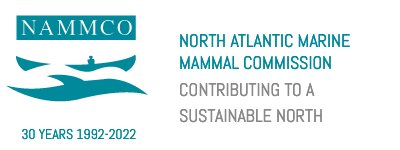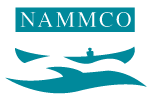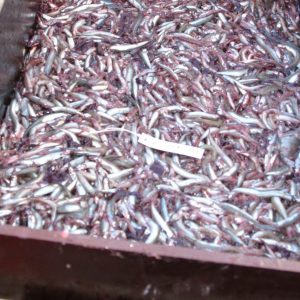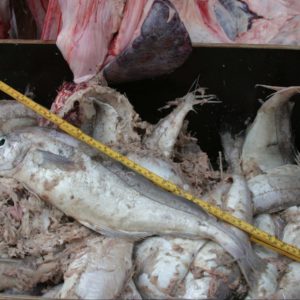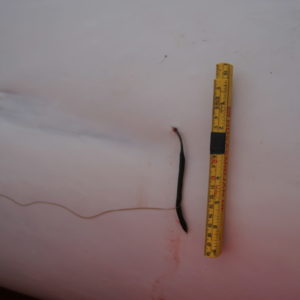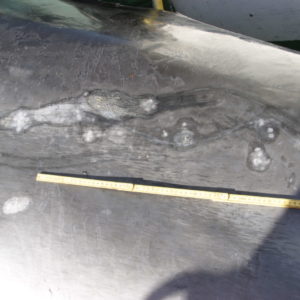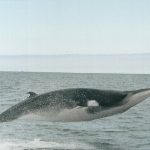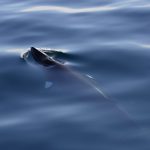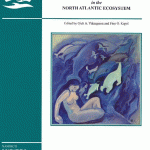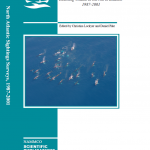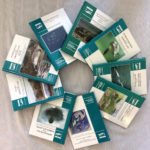Common Minke Whale
Updated: January 2021
Common minke whale is the smallest of the rorquals. It typically obtains a length of 8-9 m and a weight of about 8 tonnes in the North Atlantic. Females are somewhat larger than males. Common minke whales are black or dark grey dorsally and white on the ventral side. A transverse white band across the flippers is characteristic for the species in the Northern Hemisphere. With a worldwide distribution, it is the most common of the rorquals. The common minke whale feeds on a wide variety of fish and invertebrates and is considered an important predator in the marine ecosystem.
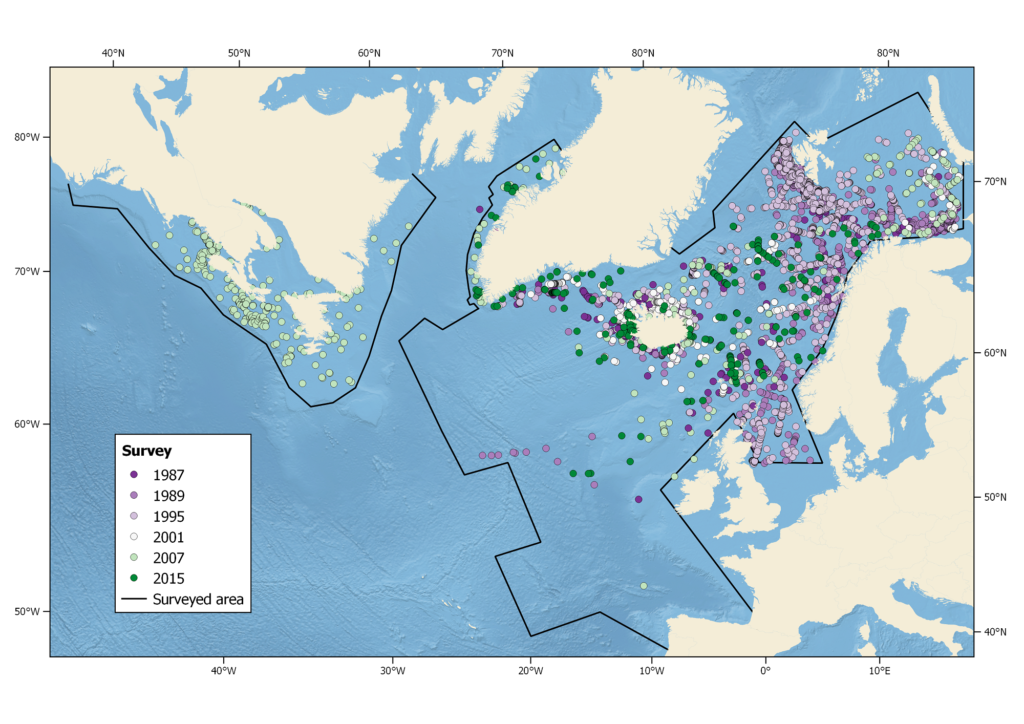
The information presented on this page focuses on stocks within the remit of NAMMCO, including stocks shared with non-NAMMCO member countries.
Abundance
The common minke whale is the most abundant baleen whale. An abundance of over 220,000 has been estimated in the North Atlantic (Guldborg Hansen et al. 2018, IWC, NAMMCO 2019, NMFS 2016; Pike et al. 2019, Solvang et al. 2021).
Distribution
Common minke whales have extensive seasonal migrations, moving from wintering areas in the tropics or sub-tropics to higher latitude feeding areas in the summer. Major summering areas include the North, Norwegian and Barents Seas, the coastal waters of Iceland, east and west Greenland, Newfoundland and Labrador, and the northeastern coast of the USA.
Relation to Humans
In 2023, whaling activities conducted by Norway and Greenland took a total of 689 minke whales.
Conservation and Management
There are international management regimes for the conservation and use of minke whales from the International Whaling Commission and NAMMCO. All stocks are currently considered to be in a healthy state and not threatened by present levels of use for human purposes.
The common minke whale is listed as being of ‘Least Concern’ on both the European regional and global IUCN Red List (2023 and 2018, respectively). Norwegian and Iceland national red lists also list as a ‘Least Concern’ species.
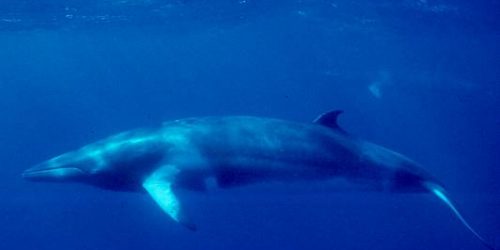

Minke whale surfacing in calm blue sea, Bjørnøya. © George McCallum / Whalephoto.com
Scientific name: Balaenoptera acutorostrata (Lacépède 1804). The North Atlantic common minke whale is the subspecies Balaenoptera acutorostrata acutorostrata.
Faroese: Sildreki
Greenlandic:Tikaagullik
Icelandic: Hrefna
Norwegian: Vågehval
Danish: Vågehval, sildepisker
English: Common minke whale, Northern minke whale, lesser rorqual, little piked whale, pikehead, sharp headed finner
Lifespan
Up to 60 years.
Average size
8-10 m long, 9 tonnes in the Northern Hemisphere. Females are larger than males.
Productivity
One calf probably every year from 7-5-78 years of age.
Feeding
Lunge-gulping’ on euphausiids (krill) and a variety of shoaling fish including herring, capelin and cod.
Migration
In general, they perform regular migrations to feeding areas at high latitudes in spring and to breeding areas at low latitudes in autumn, although some individuals may remain on the feeding grounds also throughout the winter.
General Characteristics
The common minke whale is the smallest species of the rorqual family (also called balaenopterid family). It is also the most common of all baleen whales.

© Marine and Freshwater Research Institute, Iceland
Males and females are very similar in their general appearance although females are somewhat larger than males, as in all balaenopterids. They typically obtain a length of 8–10 m and a weight of about 9 tonnes in the North Atlantic, while they are slightly larger in the southern hemisphere (Gunnlaugsson et al. 2020).
At sea
The body of a common minke whale is relatively robust, especially compared to the other rorquals. The head is very acute in shape and the rostrum fairly flat, which gives it the nickname “pikehead”. The dorsal fin is relatively tall and falcate (i.e., curved like a sickle) and is located two-thirds of the way back along the body.

The uncommon sight of two common minke whales off Norway. Minke whales are most often seen alone in the North East Atlantic. © K.A. Fagerheim, IMR, Norway.
Common minke whales are black or dark grey dorsally and white on the ventral side, with a pale chevron (or V shaped line) on the back behind the head extending down onto the flanks. A transverse white band on the flippers is characteristic for the species in the Northern Hemisphere. The blow is low (rising to only about 2–3 m) and is very inconspicuous and rarely visible in the North Atlantic. Common minke whales do not raise their flukes when diving, although the back is well arched. Many of them are very inquisitive and can approach vessels. They can also be quite fast swimmers.
From a distance, common minke whales can be confused with bottlenose whales (and some other beaked whales), however, the latter have bulbous heads and defined beaks while the common minke whale’s head is sharply triangular and flat. In the North Atlantic, common minke whales are usually observed solitary, while beaked whales, at least bottlenose whale, are generally observed in groups.
Behaviour
In the North Atlantic, common minke whales are usually solitary, while in the Southern Hemisphere, minke whales are usually seen in groups. The behaviour most characteristic of minke whales is lunge feeding. The whales swim at high speeds with their mouth open towards their prey, then close their mouth and expel the water with the prey being caught in the baleen plates.
Common minke whales do not raise their flukes when diving, although the back is well arched. Many of them are very inquisitive and can approach vessels. They can also be quite fast swimmers.
Like other baleen whales, common minke whales exhibit some sex segregation in their migratory habits, with females arriving earlier in the northern summering areas and moving further north than males (Jonsgård 1951, Horwood 1990, Laidre et al. 2009, Haug et al. 2011, Pampoulie et al. 2012). As a result, the catch early in the season and in far northern areas, such as West Greenland and Spitsbergen, tends to include a higher proportion of females than males.

Lunge feeding common minke whale off Iceland. © Marine and Freshwater Research Institute, Iceland.
Listen to their calls off Eastern Canada (NOAA)
Life history
Common minke whales reach sexual maturity at 5–7 years of age (NAMMCO 1999, Haug et al. 2011) and can live as long as 42 years in the North Atlantic (Audunsson et al. 2013). They are essentially annual breeders, with most mature females becoming pregnant every year. Mating occurs in the late winter and gestation lasts about 10 months, with calves born in low latitudes during the winter (Martin et al. 1990). While the mating strategies of common minke whales are not well known, there is evidence of sexual segregation during the summer, with the larger females reaching higher latitudes than the smaller males. This has implications for management, as much of the catch in northern areas can be composed of females. For example, the proportion of females in the coastal West Greenland harvest ranges between 71–78% (Laidre et al. 2009).
Feeding
Common minke whales feed on a wide variety of fish and invertebrates. In the North Atlantic, they consume mainly krill (Thysanoessa spp. and Meganychtiphanesspp.), Atlantic herring (Clupea harengus), capelin (Mallotus villosus), sandeels (Ammodytidae), cod (Gadus morhua), polar cod (Boreogadus saida), haddock (Melanogrammus aeglefinus), as well as other species of fish and invertebrates (NAMMCO 1998). The diet varies both by location and over time. In the Northeast Atlantic, krill dominate the diet in far northern areas, whereas capelin, herring and haddock become more important further south in the Norwegian Sea and along coastal Norway. Sandeels and mackerel (Scomber scombrus) become more common in the diet in southern areas such as the North Sea (Haug et al. 2002, Windsland et al. 2007). In the Central Atlantic, capelin appears to make up a larger part of the diet, but herring, sandeels and cod are also important (Víkingsson et al. 2013). Interannual variations in diet composition (probably reflecting prey availability), have been noted in the Northeast Atlantic (Haug et al. 2002, Windsland et al. 2007) and around Iceland (Víkingsson et al. 2013).
Like other baleen whales, common minke whales arrive in their summer feeding areas in a relatively lean condition but accumulate blubber rapidly over the summer. Using data from whales taken in the Icelandic common minke whale harvest, Christiansen et al. (2013) determined that mature common minke whales accumulated about 0.5 cubic metres, or nearly half a tonne, of blubber over the summer feeding season. This blubber serves as an energy store for migration and reproduction in southern areas where less food is available for common minke whales.
Multi-species interactions
Common minke whales are very important predators in the marine ecosystem, particularly in the Northeast and Central Atlantic stock areas. They are estimated to consume more than 1.8 million tonnes of prey annually in the northern northeast Atlantic stock area (NAMMCO 1998), much of which is commercially important species of fish such as herring, cod and haddock. This consumption is similar in magnitude to the total commercial fishery for pelagic fish in the area (Toresen et al. 1998).
The common minke whale is the most important marine mammal predator of fish in Icelandic shelf waters, consuming about 1 million tonnes of fish per year (Sigurjónsson and Vikingsson 1997). Multispecies modelling has indicated that these levels of consumption may have important implications for the yield of commercial fisheries in the northeast and central Atlantic (NAMMCO 1998, Stefánsson et al.1997), however this modelling is still at an early stage. The effects of multi-species interactions may be counter-intuitive. For example, Lindstrøm et al. (2009), using a multi-species model for the Barents Sea including cod, capelin, herring and common minke whales, suggested that increased predation by common minke whales would actually have a positive effect on the capelin stock, even though capelin were a major food item for the whales. This occurred because common minke whales also consume cod, which are a major predator of capelin.
Predation
Common minke whales are themselves preyed upon by humans, killer whales (Orcinus orca), and perhaps by large sharks in southern latitudes. Numerous instances of killer whale predation have been observed (e.g., Ford et al. 2005). Pods of killer whales begin the hunt by chasing the common minke whale at speeds of 15-30 km/hr. In most cases, the common minke whale can maintain this speed for a longer time than the killer whales and gradually outdistances them. However, if the common minke whale is confined in a bay or otherwise unable to escape, the killer whales kill it by repeatedly ramming it or holding it underwater (Ford et al. 2005). The magnitude of killer whale predation on common minke whales and its importance at the population level is not known.
Parasites and Epibiotics
Common minke whales are a host to a number of internal and external parasites, as well as commensals and other epibiotic fauna. Off Iceland, indication of sea lamprey (Petromyzon marinus) attacks can be found on over half of the whales, while copepods such as Caligus elongatus and Pennella balaenopterae are also found on 10% of whales. The whale louse Cyamus balaenopterae, the pseudo-stalked barnacle (Xenobalanus globicipitis) and the goose barnacle (Conchoderma auritum) have also been observed (Ólafsdóttir and Shinn 2013).
Distribution
Like other baleen whales, common minke whales carry out extensive seasonal migrations, moving from wintering areas in the tropics or sub-tropics to higher latitude feeding areas in the summer (Horwood 1990). The wintering areas are not well described, however the few satellite tag applications that have encompassed the fall migration suggest that common minke whales summer in the northeast Atlantic and around Iceland, and spend the winter in the southern North Atlantic at latitudes below 30° N (IWC 2014a, Víkingsson and Heide-Jørgensen 2014). Summering areas are well known from past whaling activities and more recent surveys.
Major summering areas include the North, Norwegian and Barents Seas, the coastal waters of Iceland, east and west Greenland, Newfoundland and Labrador, and the northeastern coast of the USA. In some areas, common minke whales appear to be extending their summer range northward. There have been sightings of common minke whales in areas of Arctic Canada in recent decades where they were not previously known by local residents (Higdon and Ferguson 2011), as well as an increase in takes in northern communities of west Greenland (NAMMCO 2012b). Recent Norwegian surveys in the northeast Atlantic also suggest that there are significant distributional shifts taking place (NAMMCO 2018). These changes are likely in response to shifts in prey distribution, which themselves may be due to a warming marine climate in the area (Haug et al. 2017).

Summer distribution of common minke whales in the North Atlantic, showing sightings and effort from all North Atlantic Sightings surveys, 1987 – 2015, as well as 2007 CODA and SNESSA surveys. Not all areas were surveyed each year.
Management stocks
North Atlantic common minke whales have been divided into three management stocks by the International Whaling Commission (IWC) (Donovan 1991) – the Northeast Atlantic (including the Barents, Norwegian and North seas); the Central Atlantic (including waters around Jan Mayen, Iceland and East Greenland); and the Western Atlantic (including West Greenland and the Canadian East Coast). These are also divided into smaller sub-stock areas (“small areas”). However, the original stock and sub-stock divisions were not based on extensive biological information and recent examination of genetic data has failed to provide clear evidence of stock structure amongst common minke whales in the North Atlantic (IWC 2014a,b).
Although the NAMMCO Scientific Committee believes that there is likely only one breeding stock in the North Atlantic, for management purposes they have agreed to use 3 management regions – Western Atlantic, Central Atlantic, and North East Atlantic – each of which is divided into smaller sub-areas management units. The smaller management units used by NAMMCO correspond to the IWC small areas. Basing allowable catch advice on smaller sub-areas represents a conservative approach to management. This is because using these smaller stock boundaries lessens the chances of depletion in any one area.
Migration
The migratory pattern of the North Atlantic common minke whale—wintering in the tropics and summering at high latitudes—is similar to that of other baleen whales in the northern and southern hemispheres (Horwood 1990). Consequently, there is usually no overlap in the distributions of northern and southern hemisphere populations. Therefore, it has been surprising that Antarctic minke whales (Balaenoptera bonaaerensis), a species distinct from the common minke whale, do occasionally find their way into the North Atlantic. Glover et al. (2010) analysed DNA profiles from minke whales taken in the Norwegian hunt and found that one Antarctic minke whale was taken in 1996 and a hybrid between the two species in 2007. While such occurrences are probably quite rare, it does show that the hemispheric populations of whales are not as isolated from one another as was once assumed.
Estimates of the abundance of common minke and other species of whales in the North Atlantic have been based largely on sightings surveys conducted from ships and airplanes. The North Atlantic Sightings Surveys (NASS) provide a time-series of abundance estimates from 1987 to 2015, covering a large part of the North Atlantic. Norwegian “mosaic” surveys (NILS) cover most of the northeast Atlantic, surveying a portion of the area annually on a six-year rotation. Variation in distribution from year to year is incorporated into the variance of the resultant abundance estimate (Skaug et al. 2004).
In addition, the European SCANS and CODA surveys, the Canadian component of T-NASS 2007 and NAISS 2016, and American SNESSA surveys have contributed to our knowledge of the abundance and distribution of common minke whales. Available abundance estimates by stock area are provided in the table below.
Abundance of minke whale in the North Atlantic from NASS and associated surveys
For definition of stocks see the above map; CMA, IWC Central Medium Area, with putative stock boundaries; A/S, aerial or shipboard surveys; Bias, correction bias: - a, availability and p, perception; CI, confidence interval. CA, Canada; GL, Greenland.| Areas | Stock | Year/Survey | A/S | Abundance | Bias | CV | 95% CI | Reference |
|---|---|---|---|---|---|---|---|---|
| Canadian East Coast | Newfoundland/Labrador | 2007/NASS | A | 4,020 | a.p | 0.43 | N/A | Lawson and Gosselin (2018) |
| 2016/NASS | A | 13,008 | a.p | 0.46 | N/A | |||
| Nova Scotia/Gulf of St. Lawrence | 2007/NASS | A | 12,412 | a.p | 0.37 | N/A | ||
| 2016/CA | A | 6,158 | a.p | 0.40 | N/A | |||
| West Greenland | WG | 1993/GL | A | 8,371 | a | 0.43 | 2,414–16,929 | Larsen (1995) |
| 2005/GL | A | 10,792 | a.p | 0.59 | 3,594–32,407 | Heide-Jørgensen et al. (2008) | ||
| 2007/NASS | A | 9,066 | a.p | 0.39 | 4,333–18,973 | Hansen et al. (2018) | ||
| 2015/NASS | A | 5,095 | a.p | 0.46 | 2,171–11,961 | |||
| East Greenland | CG | 2015/NASS | A | 2,762 | a.p | 0.47 | 1,160-6,574 | |
| Central Atlantic | CIC | 1987/NASS | A | 24,532 | a | 0.32 | 13,399–44,916 | Borchers et al. (2009) |
| 2001/NASS | A | 43,633 | a.p | 0.19 | 30,148–63,149 | |||
| 2007/NASS | A | 20,834 | a.p | 0.35 | 9,808–37,042 | Pike et al. (2020b) | ||
| 2009/IS | A | 9,588 | a.p | 0.24 | 5,274–14,420 | |||
| 2016/IS | A | 13,497 | a.p | 0.50 | 3,312–55,007 | |||
| CM | 1997/NILS | S | 26,718 | a.p | 0.14 | 20,333–35,107 | Skaug et al. (2004) | |
| 2005/NILS | S | 24,890 | a.p | 0.45 | 10,727–57,751 | IWC (2010) | ||
| 2008–2013/NILS | S | 10,991 | a.p | 0.36 | 4,498–35,911 | Solvang et al. (2015) | ||
| 2014–2019 | S | 37,020 | a.p. | 0.26 | N/A | Solvang et al. (2021) | ||
| CMA | 2015/NASS | S | 48,016 | p | 0.23 | N/A | Pike (2018) | |
| Northeast Atlantic | NEA (ESW + ESE + EB + CM + EW + EN | 1988–89/NASS | S | 67,380 | p | 0.19 | 44,060–92,181 | Schweder et al. (1997) |
| 1995/NILS | S | 118,299 | a.p | 0.10 | 92,213–136,337 | |||
| 1996–2001/NILS | S | 107,205 | a.p | 0.13 | 83,180–138,169 | Skaug et al. (2004) | ||
| 2002–2007/NILS | S | 108,140 | a.p | 0.23 | 69,299–168,752 | Bøthun et al. (2009) | ||
| 2008–2013/NILS | S | 100,615 | a.p | 0.11 | 81,154–124,743 | Solvang et al. (2015) | ||
| 2014–2019 | S | 149,722 | a.p. | 0.15 | N/A | Solvang et al. (2021) |
Canadian East Coast
There are two recent estimates of common minke whale abundance from this area, suggesting an abundance in excess of 20,000 animals. As there has been no recent hunting in this area and no other known threats to the population, there is likely no conservation concern at this time.
West Greenland
The four aerial surveys that have produced usable estimates for West Greenland since 1993 suggest that abundance has fluctuated, rising until 2007 then dropping to the lowest abundance yet observed in 2015. There is evidence that common minke whales caught off West Greenland may be a component of a more widespread stock, particularly considering the high proportion of females in the catch (Laidre et al. 2009). Therefore, it is difficult to infer the status of the overall stock using results from surveys off West Greenland only. It is also possible that there is an exchange between East and West Greenland (see above), and that this contributes to the observed fluctuations (IWC 2018). The IWC Scientific Committee has advised that an annual take not exceeding 164 will not harm the stock and recent harvests have been below this level.
Central Atlantic
Seven abundance estimates for the CM sub-region of the Central Atlantic are available between 1987 and 2015, from Norwegian and NASS surveys. These have shown a general upward trend from 1989 to 1997, with stabilization thereafter until 2005, followed by a decrease in the 2008–2013 survey series. However, numbers increased again in the 2015 survey and were even higher in 2016 (Solvang et al. 2018). The general pattern suggests large-scale changes in distribution between this sub-area and adjacent areas. Given the generally low level of harvest and that there is no evidence of a long-term decline in numbers in the area, there is no conservation concern for common minke whales summering in the area.
Recent changes
The coastal area around Iceland, designated the CIC sub-region of the Central Atlantic, has been surveyed five times since 1987, most recently in 2016. Recent estimates (2007 to 2016) have been more than 50% lower than previous ones (Pike et al. 2020b). The reasons for this are unclear. Common minke whaling by Iceland has resumed only recently and the take is certainly not high enough to cause a decline of this apparent magnitude. Other possibilities include:
- a change in seasonal migration, with common minke whales arriving in the area later than in previous years;
- a change in spatial distribution, with common minke whales that previously summered in this area moving somewhere else.
The latter possibility seems most likely since in recent years, pronounced changes have occurred in oceanographic conditions and relative distribution and abundance of several species of fish (including sandeels and capelin) and seabirds in Icelandic waters (Víkingsson et al. 2015). Such changes in the distribution of important prey species would be expected to affect the distribution of common minke whales. Future surveys will attempt to address this question by extending coverage to areas not covered previously, particularly to the north and west, that might host large numbers of common minke whales.
Northeast Atlantic
Five abundance estimates are available from the northeast Atlantic covering the period from 1989 to 2013, ranging from a low of 63,730 (CV=0.19) in 1989 to a high of 112,125 (CV=0.10) in 1995. The last two estimates, covering the periods 2001–2007 and 2008–2013, are similar in magnitude. The apparent fluctuations in abundance, which are not statistically significant, may be due to changes in survey methods and coverage or changes in whale distribution between the Northeast and Central areas over the period. There is no evidence that abundance has increased or decreased from 1989 to 2015.
In recent years, the basic annual quotas have remained unchanged at around 880 whales and the catch less than 500 whales. For actual numbers regarding catches and quotas, click here. Although neither NAMMCO nor the IWC has assigned a specific conservation status to this stock, it is likely that it is in a healthy state as the numbers are large relative to present and historic harvests and there is no evidence of any downward trend in numbers.
Management
The common minke whale falls under the international management jurisdiction of the International Whaling Commission (IWC) and NAMMCO. NAMMCO provides scientific advice on stock status and sustainable takes, as well as proposals for conservation and management to member governments. In recent years, NAMMCO has focused its attention on the Central Stock at the request of Iceland.
In 2011, the NAMMCO Scientific Committee concluded that annual removals of up to 229 common minke whales from the CIC area around Iceland were safe and precautionary (NAMMCO 2012a). In 2015, the Scientific Committee determined that annual removals of up to 224 common minke whales from the CIC area were safe and precautionary until 2018 (NAMMCO 2015). This advice was reviewed and revised in 2017 and concluded that catches of up to 217 animals were safe for the period 2018-2025 (NAMMCO 2017). This advice is considered conservative because it treats common minke whales in the CIC sub-area as a closed stock, when they are likely part of a larger North Atlantic group.
NAMMCO
NAMMCO is the only inter-governmental organization presently operating an international observation program for marine mammal hunts, the NAMMCO Observation Scheme for the Hunting of Marine Mammals. The purpose of the Scheme is to provide a mechanism to collect reliable information on all kinds of marine mammal hunting activities in the member countries and to provide a mechanism to oversee whether NAMMCO recommendations are implemented, and national regulations are followed. NAMMCO appoints observers to directly oversee hunting and inspection activities in member countries. These observers, who are normally not resident in the country being observed, may go out on whaling vessels to observe hunts, check licenses and relevant certificates, and inspect whaling logbooks. An observer might also inspect landing and processing facilities. Observers report directly to the NAMMCO Secretariat.
Scientific advice
The NAMMCO Scientific Committee used all available survey, catch and other data to conclude in 2015 that annual removals of up to 224 common minke whales from the CIC area are safe and precautionary until 2018 (NAMMCO 2015). The Scientific Committee revised its advice in 2017 to conclude that catches of up to 217 animals are safe for the period 2018–2025. It emphasized that this advice is conservative because it treats common minke whales in the CIC sub-area as a closed stock, when they are likely part of a larger North Atlantic group (NAMMCO 2017). Catches in this area have been much lower than this in recent years, ranging from 24 to 81 since hunting resumed in 2003.
IWC
The IWC began establishing quotas in the 1970s. In 1986, the IWC instituted a temporary moratorium on commercial whaling. However, Norway is not bound by the moratorium as it raised a formal objection to it as permitted under the International Convention for the Regulation of Whaling. Greenland has continued to hunt common minke whales under “aboriginal subsistence” quotas from the IWC, which do not fall under the moratorium. Iceland withdrew from the IWC in 1992, after halting its common minke whale hunt in 1985. Iceland later rejoined the IWC in 2003 with an objection to the moratorium in place.
The IWC provides assessment and scientific advice on stocks that are hunted in the North Atlantic. However, it does not play a direct management role in the commercial whaling by Norway and Iceland, as this would be in conflict with the moratorium.
Aboriginal Subsistence Whaling
The IWC does provide management advice for the Aboriginal Subsistence Whaling carried out by Greenland. The recommended strike limits are based on scientific advice regarding the sustainability of the takes and the cultural and nutritional need levels of the aboriginal group. The main objectives for Aboriginal Subsistence Whaling are:
- to ensure the risk of extinction is not seriously increased,
- to enable harvests in perpetuity appropriate to cultural and nutritional requirements,
- to maintain stocks at their highest net recruitment level and if below that to ensure they move towards it.
This approach means that while quotas for commercial whaling may be limited primarily by sustainability criteria, allowable takes for Aboriginal Subsistence Whaling are determined by a combination of sustainability criteria and levels of nutritional and cultural need. Greenland has expressed a need for 666 tonnes of whale meat annually. The annual quotas of minke, fin, humpback and bowhead whales would produce a total of about 574 tonnes, with meat from minke whales comprising about 50% of the total (Greenland 2012). In 2018, the IWC advised that a continuation of the present average annual strike limit of 164 whales would not harm the stock and met the conservation objectives (IWC 2018).
The Revised Management Procedure
While the IWC does not presently provide catch limits for commercial whaling, it has developed a methodology for doing so – the Revised Management Procedure (RMP). The RMP was developed by the IWC Scientific Committee and accepted by the Commission in 1994. The RMP has three main objectives:
- Stable catch limits;
- No catch for populations below 54% of their original size, or the “carrying capacity” of the habitat;
- Maximizing yield within conservation limitations.
The RMP uses a Catch Limit Algorithm (CLA) to calculate catch limits. The CLA uses available estimates of abundance with associated uncertainty and the historic catch series to calculate maximum allowable catch limits. Before the RMP and its CLA are implemented for a particular stock, it must be rigorously tested using various stock boundaries and distributions using computer simulations. While the RMP has not yet been used by the IWC to provide catch limit advice, the Scientific Committee continues to develop the procedure and implement it for various whale stocks. It is also used by Norway to set their own national quotas.
In addition to the international management regimes of NAMMCO and the IWC, each country has its own management program to regulate common minke whaling.
Iceland
In recent years, Iceland has set its common minke whale quota in accordance with advice from NAMMCO. Recent quotas have been around 200 animals annually, although actual catches have been considerably less than this. In 2019, an annual quota of 217 minke whales was reaffirmed as applying between 2018 and 2023.
Icelandic regulations require that the gunner take a course in the handling and firing of grenades and harpoons. The gunner must also hold a general firearms license to handle the backup weapon. Other regulations specify the size and type of weaponry and equipment used in the hunt (NAMMCO 2011a). Hunters are required to report their catch, including the sex, length and location of each animal taken, to the Directorate of Fisheries. National inspectors accompany whaling boats on a random, unannounced basis.
Iceland maintains a DNA registry modelled after that of Norway (see below).
Norway

Minke whale surfacing in calm blue sea, Bjørnøya. © George McCallum / Whalephoto.com
The Norwegian Ministry of Trade, Industry and Fisheries sets its own common minke whale basic quotas for six years based on the modified RMP implementation for the northeastern stock developed by the IWC Scientific Committee. The system defines an annual sustainable total level of removals for the whole Norwegian area and then attributes specific quotas to the different management areas depending on the abundance in each area. If the entire annual basic quota is not taken, the remaining whales can be added to the basic quota when the next year’s quota is decided (the carry over system). Whaling is restricted to the spring and summer seasons. In recent years, the the annual catches have been less than 500 whales. For actual numbers regarding catches and quotas, click here.
Equipment regulation
Norway also regulates the equipment used in common minke whale hunting to help ensure hunter safety and minimize animal suffering. This includes requirements for the size and type of harpoon guns, grenade type and charge, the minimum calibre and type of secondary killing rifles, and other equipment. All prospective whalers and gunners must pass an obligatory training course, including a shooting course, in order to obtain a licence (NAMMCO 2011a).
Electronic monitoring system
Norway has largely replaced human inspectors with an electronic monitoring system to independently monitor the activities of whalers (NAMMCO 2004, NAMMCO 2005, NAMMCO 2011a). The system was fully implemented in 2006. The “blue box” unit consists of a control and data logger designed to independently monitor and log hunting activity data provided by an independent GPS (time and position), as well as different sensors such as shot transducers, strain transducers and heel sensors placed in critical areas and structures of the boat, to detect when and where a whale is shot and taken on board.
The sealed, tamper-proof unit can operate without maintenance for up to four months and collected data are encrypted. After the hunting season, the encrypted data are collected from the Blue Box, decrypted and analysed by authorized personnel in the Directorate of Fisheries. In addition to the automated monitoring system, inspectors from the Directorate of Fisheries conduct periodic random checks of hunting activities.
DNA registry
The legitimacy of the harvest is further ensured through the operation of the world’s first wildlife DNA registry. A sample is obtained from every legally taken minke whale. The analysis of 12 DNA loci allows for the individual identification of whales through a kind of DNA “fingerprint”. Meat and other products brought to market can then be sampled to check that all the products come from legally taken whales. The efficacy of this system was recently demonstrated by a study that included sampling of market products and samples from two beached minke whales. All market products were identified as being from legally-caught whales, while the samples from the beached whales were not (Palsbøll et al. 2006).
Hunting and Utilisation
Whaling has been conducted in the North Atlantic for thousands of years. However, hunting specifically directed towards common minke whales is relatively recent (Kalland 1995, Sigurjónsson 1997). Common minke whaling developed in the 20th century in Norway, Iceland, Greenland and Canada, and has been primarily carried out on a small scale by fishermen from small vessels, as a supplement to their fishing activity. The main product from the common minke whale hunt has always been meat for human consumption. At present, common minke whaling is carried out by only three countries in the North Atlantic: Norway, Iceland and Greenland.
Greenland

Collective common minke whale hunt in Greenland. © F. Sejersen
The Greenlandic catch is taken primarily from the West Greenland stock area, but a small proportion is taken by East Greenlanders from the Central stock area. Catches have been relatively stable over the past 10 years, ranging from 140–200 whales for all of Greenland. Whaling in Greenland was not affected by the IWC moratorium on commercial whaling, as the hunt is “Aboriginal Subsistence Whaling” rather than commercial whaling.
The hunt
Whales are hunted for the most part using methods similar to those used in Norway. Between 40 and 50 vessels in Greenland are equipped with harpoon cannons, hunting common minke and larger whales (Greenland 2018). However, about 20% to 30% of the quota is taken by small boats in a collective rifle hunt. This type of hunting is done primarily in isolated communities that lack vessels equipped with harpoon cannons, such as those north of Disko Bay and in East Greenland. Generally, five or more small boats and crews participate in such hunts.
The hunters first fire into the water to drive the whale towards shallow water, where it can more easily be retrieved. Once the whale is in a suitable area, it is shot non-lethally to slow it down so that the hunters may approach close enough to harpoon it. As soon as possible, the whale is secured with harpoons attached by lines to large floats. When a sufficient number of floats are attached to prevent the whale from sinking, it is killed with rifle shots to the brain (Larsen and Hansen 1997, NAMMCO 2011a).
Whales killed in the collective rifle hunts are towed to shore and butchered on the beach. This is also done by some vessels participating in the harpoon cannon hunt if they are not equipped for onboard processing.
Time to death
During the years 2007 to 2011, median times to death were recorded as 1 to 5 minutes, with 20% of the whales died instantaneously or within 1 minute; this contrasts with the instantaneous death rate of 80% in the Norwegian hunt (Greenland 2012, NAMMCO 2011a). The reasons for this difference are not clear but may include differences in monitoring methods, inferior weaponry and a lack of training for hunters. The struck-and-lost rate for this hunt during the same period was just 1% (Greenland 2012).
In the collective hunts, only a small proportion of the whales are killed instantly or quickly and the median time to death ranged from 20 to 25 minutes (Greenland 2012). This is integral to the nature of the hunt as the whale must be secured with several harpoons before it is killed to prevent loss. This is a feature of many marine mammal hunts where the need to secure the animal and prevent struck-and-loss must be balanced against the ideal of an instantaneous kill (NAMMCO EG 2007). The struck-and-lost rate for this hunt averaged 6% from 2007 to 2011 (Greenland 2012).
Use
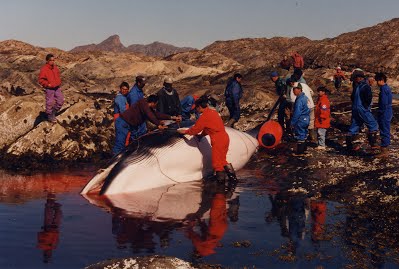
Onshore processing of common minke whale in Greenland. © F. Sejersen
In Greenland, the meat of the common minke whale is a welcome food. The skin and subcutaneous fat, called mattak, is also consumed. The ventral grooves (Greenlandicqiporaq) are considered a particular delicacy. The baleen and bones are sometimes used for carving and other crafts. Consumption of minke whale meat in Greenland over the past decade has been roughly 340 tonnes annually, making the minke whale hunt the largest source of whale meat in Greenland (Greenland 2012).
Historically, the catch of common minke whales or other large animals was divided and shared among participating hunters and their extended families according to complex traditional rules (Inuktitut ningiqtuq, Greenlandic ningerpoq). This helped to ensure that the entire camp or community received a portion of the catch (Wenzel 1995, Sejersen 2001).
In the case of common minke and other large whales, however, sales for cash are very important as a means of maintaining the hunt. Operating a whaler equipped with a harpoon cannon can be very expensive – the cannon alone might cost US $60,000 and each grenade costs as much as US $1,500 (Greenland 2012) and fuel is also very expensive in Greenland. Therefore, some portion of the catch is sold in the open-air markets (Greenlandic Kalaalimineerniarfik, Danish brædtet) present in every village and town, as well as in supermarkets and restaurants. In addition to providing a needed source of income for hunters, this practice also supplies meat to areas in Greenland that cannot access a sufficient supply locally.
Iceland
Whaling has been carried out in Iceland since medieval times. Whales of various species were harpooned, speared and/or driven ashore, and natural strandings were also utilized for food if they were fresh enough. Indeed, the Icelandic word for a stranded whale, hvalreki, is today synonymous with an extremely fortunate event or “godsend” (Sigurjónsson 1989). Modern whaling began in the late 1800s, but this was targeted mainly at the larger blue and fin whales. Common minke whaling began early in the 20th century and was carried out by fishermen as a seasonal occupation.
Initially, the catch of common minke whales was small and consumed domestically, averaging about 50 animals annually before 1950 (Sigurjónsson 1989). Gradually, the export market, primarily to Japan, became more important and hunting increased to around 200 annually by 1986, when whaling was discontinued in conformity with the IWC moratorium on commercial whaling that took effect that year. Common minke whaling resumed in 2003 under Scientific Permit and commercial whaling was resumed in 2006. Over the last decades, 40-80 whales have been hunted annually. The Icelandic catch of common minke whales is taken by vessels operating in coastal waters, from the CIC small area of the Central Stock.
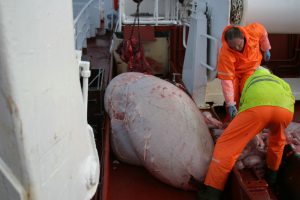
The Icelandic Minke Whale Research Program. Sampling of stomach content. © Marine and Freshwater Research Institute, Iceland.
Common minke whaling in Iceland is carried by small fishing vessels using harpoon cannons with exploding penthrite grenades; methods identical to those used in Norway. The catch is also processed at sea as in Norway.
Time to death (TTD) data were collected in the 2014 and 2105 season in Iceland. However, the result from the study was inconclusive, due to small sample size (NAMMCO 2015). The efficiency of the hunt is assumed to be similar to that in Norway (NAMMCO 2011a).
Use
Since common minke whaling resumed in 2003, all common minke whale products have been consumed within Iceland. Whale meat was once a common staple in Iceland but became largely unavailable after the cessation of whaling in 1986. Whale meat is now available at butcher shops, supermarkets and restaurants throughout the country and is prepared and consumed much like any other meat. A particular delicacy in Iceland is made from the ventral groove blubber pickled in sour milk (Hvalrengi). This preservation method using lactic acid derived from milk (súrmattur) is unique to Iceland and the foundation of many traditional Icelandic dishes (Sigurgeirsson 2001).
For the first time since hunting resumed in 2003, in 2019 no hunt for common minke whales took place in Iceland. The minke whaling company IP útgerð that usually services the domestic Icelandic market chose to instead focus on harvesting sea cucumbers and to import minke whale meat from Norway (Kyzer 2019).

Norwegian common minke whaling with a harpoon cannon and explosive harpoon head. © T. Haug, IMR, Norway.
Norway
The Norwegian catch is taken primarily from the Northeastern stock area, but a small proportion may be taken from the Central stock area around Jan Mayen. Norway also took common minke whales in the West Greenland stock area until 1986. Prior to 1986, the year in which the IWC moratorium on commercial whaling took effect, the annual catches were approaching 2000 animals. Although Norway held a reservation to this decision and was not legally bound by it, it nevertheless temporarily ceased commercial whaling from 1988 to 1992, a period in which only scientific research whaling was permitted. In 1993 Norway resumed commercial whaling. Recent catches have been in the range of 500 to 700 annually.
The hunt
Whales are hunted from small (ca 50 ft) fishing vessels that are equipped for whaling in the spring and summer but fish the remainder of the year. The vessels are equipped with 50 mm or 60 mm harpoon cannons that use a gunpowder charge to fire the harpoon. The harpoons are of the “hot” type, tipped with explosive grenades loaded with 30 g of penthrite explosive. This grenade is triggered to detonate inside the whale and is designed to kill the animal as quickly as possible to minimise suffering. A line attached to the harpoon secures the whale and prevents loss, and a winch is used to haul the animal to the boat (NAMMCO 2011a).

Flensing of a minke whale onboard a Norwegian vessel (1994). © B.T. Forberg, IMR, Norway.
The harpooner generally shoots the whale from the side and aims for the thorax region. A large calibre rifle is used as a secondary killing method if required. This is usually not necessary though. The IDR (instantaneous death rate) from the harpoon shot alone was over 80% in 1,667 hunts monitored between 2000 and 2002 (NAMMCO 2011a). In 2011 – 2012 Norway again collected time to death (TTD) data and the IDR rate was 82 %. Most of the remainder died within a few minutes and only a small proportion had to be re-shot with the harpoon gun or dispatched with a rifle shot to the brain. Once the whale is secured, it is flensed onboard the vessel. Meat and other products are first cooled in the open air then stored on ice until the vessel returns to port.
Hunting methods
Norway has conducted extensive research to improve methods to quickly and humanely kill whales and is the only country to do so in modern times. A major focus of this research has been the development and refinement of the explosive penthrite grenades used in the hunt, which replaced the “cold” non-explosive harpoon heads used earlier. The initial development and deployment of the penthrite grenade was completed in 1986 but refinement of the weaponry is ongoing. The use of the explosive grenades greatly increased the instantaneous death rate to over 80% today as opposed to only 17% for the cold harpoon, as well as greatly reducing the average time to death. In addition, post-mortem studies of killed whales have been used to determine the actual cause of death and to provide information to hunters to refine their abilities.
Export
Norway used to export whale meat and blubber, primarily to Japan, but this trade ceased in 1983 when the Committee on the International Trade in Endangered Species (CITES) agreed to a trade ban on whale products. While Norway held a reservation on this decision, it nevertheless voluntarily stopped exporting whale products. In 2001, Norway granted permission for export sales to resume, and there has been a minor international trade, especially to Japan, since that time. Virtually all whale products are consumed within Norway. The meat is sold fresh or frozen in grocery stores, butcher shops and fish stores throughout Norway. It is also commonly offered in restaurants. Some of the meat is processed into products such as sausages and burgers.
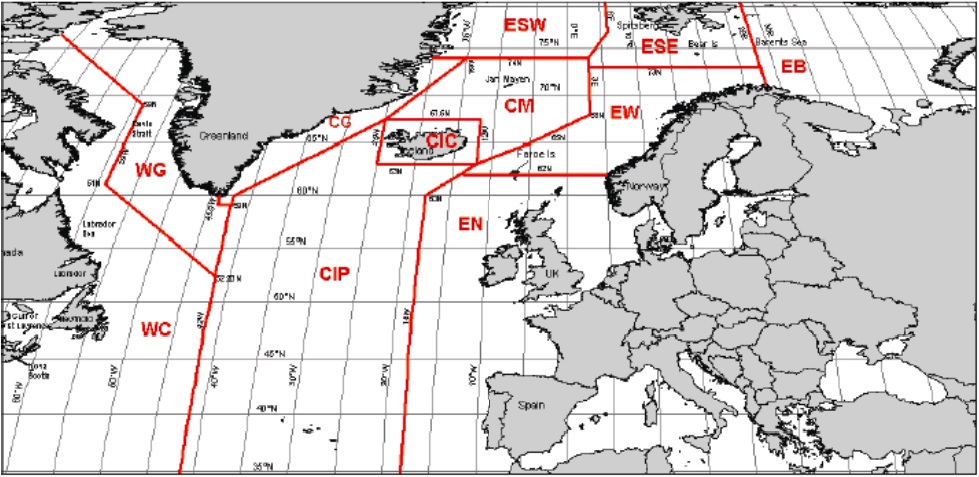
Map of the North Atlantic showing the sub-areas defined for the North Atlantic common minke whales. The E area for Norway in the database below is a compilation of the catches in the EB, EN, ES and EW sub-areas.
Catches in NAMMCO member countries since 1992
| Country | Species (common name) | Species (scientific name) | Year or Season | Area or Stock | Catch Total | Quota (if applicable) |
|---|---|---|---|---|---|---|
| Greenland | Common minke whale | Balaenoptera acutorostrata | 2023 | West | 164 | 188 |
| Greenland | Common minke whale | Balaenoptera acutorostrata | 2023 | East | 18 | 24 |
| Greenland | Common minke whale | Balaenoptera acutorostrata | 2022 | West | 146 | 206 |
| Greenland | Common minke whale | Balaenoptera acutorostrata | 2022 | East | 17 | 21 |
| Greenland | Common minke whale | Balaenoptera acutorostrata | 2021 | West | 167 | 219 |
| Greenland | Common minke whale | Balaenoptera acutorostrata | 2021 | East | 21 | 22 |
| Greenland | Common minke whale | Balaenoptera acutorostrata | 2020 | East | 20 | 23 |
| Greenland | Common minke whale | Balaenoptera acutorostrata | 2020 | West | 162 | 216 |
| Greenland | Common minke whale | Balaenoptera acutorostrata | 2020 | Total | 182 | 239 |
| Greenland | Common minke whale | Balaenoptera acutorostrata | 2019 | East | 11 | 20 |
| Greenland | Common minke whale | Balaenoptera acutorostrata | 2019 | West | 160 | 164 |
| Greenland | Common minke whale | Balaenoptera acutorostrata | 2019 | Total | 171 | 184 |
| Greenland | Common minke whale | Balaenoptera acutorostrata | 2018 | East | 2 | 15 |
| Greenland | Common minke whale | Balaenoptera acutorostrata | 2018 | West | 116 | 179 |
| Greenland | Common minke whale | Balaenoptera acutorostrata | 2018 | Total | 118 | 194 |
| Greenland | Common minke whale | Balaenoptera acutorostrata | 2017 | East | 10 | 15 |
| Greenland | Common minke whale | Balaenoptera acutorostrata | 2017 | West | 133 | 179 |
| Greenland | Common minke whale | Balaenoptera acutorostrata | 2017 | Total | 143 | 194 |
| Greenland | Common minke whale | Balaenoptera acutorostrata | 2016 | East | 15 | 15 |
| Greenland | Common minke whale | Balaenoptera acutorostrata | 2016 | West | 148 | 179 |
| Greenland | Common minke whale | Balaenoptera acutorostrata | 2016 | Total | 163 | 194 |
| Greenland | Common minke whale | Balaenoptera acutorostrata | 2015 | East | 6 | 15 |
| Greenland | Common minke whale | Balaenoptera acutorostrata | 2015 | West | 133 | 179 |
| Greenland | Common minke whale | Balaenoptera acutorostrata | 2015 | Total | 139 | 194 |
| Greenland | Common minke whale | Balaenoptera acutorostrata | 2014 | East | 11 | 15 |
| Greenland | Common minke whale | Balaenoptera acutorostrata | 2014 | West | 146 | 164 |
| Greenland | Common minke whale | Balaenoptera acutorostrata | 2014 | Total | 157 | 179 |
| Greenland | Common minke whale | Balaenoptera acutorostrata | 2013 | East | 6 | 12 |
| Greenland | Common minke whale | Balaenoptera acutorostrata | 2013 | West | 175 | 178 |
| Greenland | Common minke whale | Balaenoptera acutorostrata | 2013 | Total | 181 | 190 |
| Greenland | Common minke whale | Balaenoptera acutorostrata | 2012 | East | 4 | 15 |
| Greenland | Common minke whale | Balaenoptera acutorostrata | 2012 | West | 148 | 183 |
| Greenland | Common minke whale | Balaenoptera acutorostrata | 2012 | Total | 152 | 198 |
| Greenland | Common minke whale | Balaenoptera acutorostrata | 2011 | East | 10 | 15 |
| Greenland | Common minke whale | Balaenoptera acutorostrata | 2011 | West | 179 | 185 |
| Greenland | Common minke whale | Balaenoptera acutorostrata | 2011 | Total | 189 | 200 |
| Greenland | Common minke whale | Balaenoptera acutorostrata | 2010 | East | 9 | 15 |
| Greenland | Common minke whale | Balaenoptera acutorostrata | 2010 | West | 187 | 193 |
| Greenland | Common minke whale | Balaenoptera acutorostrata | 2010 | Total | 196 | 208 |
| Greenland | Common minke whale | Balaenoptera acutorostrata | 2009 | East | 4 | 15 |
| Greenland | Common minke whale | Balaenoptera acutorostrata | 2009 | West | 164 | 215 |
| Greenland | Common minke whale | Balaenoptera acutorostrata | 2009 | Total | 168 | 230 |
| Greenland | Common minke whale | Balaenoptera acutorostrata | 2008 | East | 1 | 12 |
| Greenland | Common minke whale | Balaenoptera acutorostrata | 2008 | West | 151 | 200 |
| Greenland | Common minke whale | Balaenoptera acutorostrata | 2008 | Total | 152 | 212 |
| Greenland | Common minke whale | Balaenoptera acutorostrata | 2007 | East | 2 | 15 |
| Greenland | Common minke whale | Balaenoptera acutorostrata | 2007 | West | 167 | 169 |
| Greenland | Common minke whale | Balaenoptera acutorostrata | 2007 | Total | 169 | 184 |
| Greenland | Common minke whale | Balaenoptera acutorostrata | 2006 | East | 3 | 14 |
| Greenland | Common minke whale | Balaenoptera acutorostrata | 2006 | West | 181 | 175 |
| Greenland | Common minke whale | Balaenoptera acutorostrata | 2006 | Total | 184 | 189 |
| Greenland | Common minke whale | Balaenoptera acutorostrata | 2005 | East | 4 | 12 |
| Greenland | Common minke whale | Balaenoptera acutorostrata | 2005 | West | 176 | 176 |
| Greenland | Common minke whale | Balaenoptera acutorostrata | 2005 | Total | 180 | 188 |
| Greenland | Common minke whale | Balaenoptera acutorostrata | 2004 | East | 11 | 10 |
| Greenland | Common minke whale | Balaenoptera acutorostrata | 2004 | West | 179 | 180 |
| Greenland | Common minke whale | Balaenoptera acutorostrata | 2004 | Total | 190 | 190 |
| Greenland | Common minke whale | Balaenoptera acutorostrata | 2003 | East | 14 | 12 |
| Greenland | Common minke whale | Balaenoptera acutorostrata | 2003 | West | 185 | 190 |
| Greenland | Common minke whale | Balaenoptera acutorostrata | 2003 | Total | 199 | 202 |
| Greenland | Common minke whale | Balaenoptera acutorostrata | 2002 | East | 10 | 10 |
| Greenland | Common minke whale | Balaenoptera acutorostrata | 2002 | West | 139 | 190 |
| Greenland | Common minke whale | Balaenoptera acutorostrata | 2002 | Total | 149 | 200 |
| Greenland | Common minke whale | Balaenoptera acutorostrata | 2001 | East | 17 | 12 |
| Greenland | Common minke whale | Balaenoptera acutorostrata | 2001 | West | 139 | 190 |
| Greenland | Common minke whale | Balaenoptera acutorostrata | 2001 | Total | 156 | 202 |
| Greenland | Common minke whale | Balaenoptera acutorostrata | 2000 | East | 10 | 10 |
| Greenland | Common minke whale | Balaenoptera acutorostrata | 2000 | West | 145 | 190 |
| Greenland | Common minke whale | Balaenoptera acutorostrata | 2000 | Total | 155 | 200 |
| Greenland | Common minke whale | Balaenoptera acutorostrata | 1999 | East | 15 | 14 |
| Greenland | Common minke whale | Balaenoptera acutorostrata | 1999 | West | 170 | 190 |
| Greenland | Common minke whale | Balaenoptera acutorostrata | 1999 | Total | 185 | 204 |
| Greenland | Common minke whale | Balaenoptera acutorostrata | 1998 | East | 10 | 12 |
| Greenland | Common minke whale | Balaenoptera acutorostrata | 1998 | West | 166 | 190 |
| Greenland | Common minke whale | Balaenoptera acutorostrata | 1998 | Total | 176 | 202 |
| Greenland | Common minke whale | Balaenoptera acutorostrata | 1997 | East | 14 | 14 |
| Greenland | Common minke whale | Balaenoptera acutorostrata | 1997 | West | 148 | 180 |
| Greenland | Common minke whale | Balaenoptera acutorostrata | 1997 | Total | 162 | 194 |
| Greenland | Common minke whale | Balaenoptera acutorostrata | 1996 | East | 12 | 15 |
| Greenland | Common minke whale | Balaenoptera acutorostrata | 1996 | West | 164 | 180 |
| Greenland | Common minke whale | Balaenoptera acutorostrata | 1996 | Total | 176 | 195 |
| Greenland | Common minke whale | Balaenoptera acutorostrata | 1995 | East | 9 | 15 |
| Greenland | Common minke whale | Balaenoptera acutorostrata | 1995 | West | 153 | 180 |
| Greenland | Common minke whale | Balaenoptera acutorostrata | 1995 | Total | 162 | 195 |
| Greenland | Common minke whale | Balaenoptera acutorostrata | 1994 | East | 5 | 15 |
| Greenland | Common minke whale | Balaenoptera acutorostrata | 1994 | West | 104 | 130 |
| Greenland | Common minke whale | Balaenoptera acutorostrata | 1994 | Total | 109 | 145 |
| Greenland | Common minke whale | Balaenoptera acutorostrata | 1993 | East | 9 | 14 |
| Greenland | Common minke whale | Balaenoptera acutorostrata | 1993 | West | 107 | 130 |
| Greenland | Common minke whale | Balaenoptera acutorostrata | 1993 | Total | 116 | 144 |
| Greenland | Common minke whale | Balaenoptera acutorostrata | 1992 | East | 11 | 15 |
| Greenland | Common minke whale | Balaenoptera acutorostrata | 1992 | West | 103 | 130 |
| Greenland | Common minke whale | Balaenoptera acutorostrata | 1992 | Total | 114 | 145 |
| Iceland | Common minke whale | Balaenoptera acutorostrata | 2023 | Iceland Coastal (CIC) | 0 | 260 |
| Iceland | Common minke whale | Balaenoptera acutorostrata | 2022 | Iceland Coastal (CIC) | 0 | 260 |
| Iceland | Common minke whale | Balaenoptera acutorostrata | 2021 | Iceland Coastal (CIC) | 1 | 260 |
| Iceland | Common minke whale | Balaenoptera acutorostrata | 2020 | Iceland Coastal (CIC) | 0 | 217 |
| Iceland | Common minke whale | Balaenoptera acutorostrata | 2019 | Iceland Coastal (CIC) | 0 | 217 |
| Iceland | Common minke whale | Balaenoptera acutorostrata | 2018 | Iceland Coastal (CIC) | 6 | 217 |
| Iceland | Common minke whale | Balaenoptera acutorostrata | 2017 | Iceland Coastal (CIC) | 17 | 269 |
| Iceland | Common minke whale | Balaenoptera acutorostrata | 2016 | Iceland Coastal (CIC) | 46 | 264 |
| Iceland | Common minke whale | Balaenoptera acutorostrata | 2015 | Iceland Coastal (CIC) | 29 | 275 |
| Iceland | Common minke whale | Balaenoptera acutorostrata | 2014 | Iceland Coastal (CIC) | 24 | 229 |
| Iceland | Common minke whale | Balaenoptera acutorostrata | 2013 | Iceland Coastal (CIC) | 35 | 229 |
| Iceland | Common minke whale | Balaenoptera acutorostrata | 2012 | Iceland Coastal (CIC) | 52 | 229 |
| Iceland | Common minke whale | Balaenoptera acutorostrata | 2011 | Iceland Coastal (CIC) | 58 | 216 |
| Iceland | Common minke whale | Balaenoptera acutorostrata | 2010 | Iceland Coastal (CIC) | 60 | 200 |
| Iceland | Common minke whale | Balaenoptera acutorostrata | 2009 | Iceland Coastal (CIC) | 81 | 200 |
| Iceland | Common minke whale | Balaenoptera acutorostrata | 2008 | Iceland Coastal (CIC) | 38 | |
| Iceland | Common minke whale | Balaenoptera acutorostrata | 2007 | Iceland Coastal (CIC) | 43 | |
| Iceland | Common minke whale | Balaenoptera acutorostrata | 2006 | Iceland Coastal (CIC) | 61 | |
| Iceland | Common minke whale | Balaenoptera acutorostrata | 2005 | Iceland Coastal (CIC) | 39 | |
| Iceland | Common minke whale | Balaenoptera acutorostrata | 2004 | Iceland Coastal (CIC) | 25 | |
| Iceland | Common minke whale | Balaenoptera acutorostrata | 2003 | Iceland Coastal (CIC) | 37 | |
| Iceland | Common minke whale | Balaenoptera acutorostrata | 1992-2002 | Iceland Coastal (CIC) | 0 | |
| Norway | Common minke whale | Balaenoptera acutorostrata | 2023 | E | 507 | 747 |
| Norway | Common minke whale | Balaenoptera acutorostrata | 2023 | CM | 0 | 253 |
| Norway | Common minke whale | Balaenoptera acutorostrata | 2023 | Total | 507 | 1000 |
| Norway | Common minke whale | Balaenoptera acutorostrata | 2022 | E | 581 | 664 |
| Norway | Common minke whale | Balaenoptera acutorostrata | 2022 | CM | 0 | 253 |
| Norway | Common minke whale | Balaenoptera acutorostrata | 2022 | Total | 586 | 917 |
| Norway | Common minke whale | Balaenoptera acutorostrata | 2021 | E | 577 | 1108 |
| Norway | Common minke whale | Balaenoptera acutorostrata | 2021 | CM | 0 | 170 |
| Norway | Common minke whale | Balaenoptera acutorostrata | 2021 | Total | 586 | 1278 |
| Norway | Common minke whale | Balaenoptera acutorostrata | 2020 | E | 505 | 1108 |
| Norway | Common minke whale | Balaenoptera acutorostrata | 2020 | CM | 0 | 170 |
| Norway | Common minke whale | Balaenoptera acutorostrata | 2020 | Total | 505 | 1278 |
| Norway | Common minke whale | Balaenoptera acutorostrata | 2019 | E | 429 | 1108 |
| Norway | Common minke whale | Balaenoptera acutorostrata | 2019 | CM | 0 | 170 |
| Norway | Common minke whale | Balaenoptera acutorostrata | 2019 | Total | 429 | 1278 |
| Norway | Common minke whale | Balaenoptera acutorostrata | 2018 | E | 454 | 1108 |
| Norway | Common minke whale | Balaenoptera acutorostrata | 2018 | CM | 0 | 170 |
| Norway | Common minke whale | Balaenoptera acutorostrata | 2018 | Total | 454 | 1278 |
| Norway | Common minke whale | Balaenoptera acutorostrata | 2017 | E | 432 | 829 |
| Norway | Common minke whale | Balaenoptera acutorostrata | 2017 | CM | 0 | 170 |
| Norway | Common minke whale | Balaenoptera acutorostrata | 2017 | Total | 432 | 999 |
| Norway | Common minke whale | Balaenoptera acutorostrata | 2016 | E | 591 | 710 |
| Norway | Common minke whale | Balaenoptera acutorostrata | 2016 | CM | 0 | 170 |
| Norway | Common minke whale | Balaenoptera acutorostrata | 2016 | Total | 591 | 880 |
| Norway | Common minke whale | Balaenoptera acutorostrata | 2015 | E | 660 | 1016 |
| Norway | Common minke whale | Balaenoptera acutorostrata | 2015 | CM | 0 | 270 |
| Norway | Common minke whale | Balaenoptera acutorostrata | 2015 | Total | 660 | 1286 |
| Norway | Common minke whale | Balaenoptera acutorostrata | 2014 | E | 736 | 1016 |
| Norway | Common minke whale | Balaenoptera acutorostrata | 2014 | CM | 0 | 270 |
| Norway | Common minke whale | Balaenoptera acutorostrata | 2014 | Total | 736 | 1286 |
| Norway | Common minke whale | Balaenoptera acutorostrata | 2013 | E | 594 | 1016 |
| Norway | Common minke whale | Balaenoptera acutorostrata | 2013 | CM | 0 | 270 |
| Norway | Common minke whale | Balaenoptera acutorostrata | 2013 | Total | 594 | 1286 |
| Norway | Common minke whale | Balaenoptera acutorostrata | 2012 | E | 464 | 1016 |
| Norway | Common minke whale | Balaenoptera acutorostrata | 2012 | CM | 0 | 270 |
| Norway | Common minke whale | Balaenoptera acutorostrata | 2012 | Total | 464 | 1286 |
| Norway | Common minke whale | Balaenoptera acutorostrata | 2011 | E | 533 | 1016 |
| Norway | Common minke whale | Balaenoptera acutorostrata | 2011 | CM | 0 | 270 |
| Norway | Common minke whale | Balaenoptera acutorostrata | 2011 | Total | 533 | 1286 |
| Norway | Common minke whale | Balaenoptera acutorostrata | 2010 | E | 467 | 1016 |
| Norway | Common minke whale | Balaenoptera acutorostrata | 2010 | CM | 1 | 270 |
| Norway | Common minke whale | Balaenoptera acutorostrata | 2010 | Total | 468 | 1286 |
| Norway | Common minke whale | Balaenoptera acutorostrata | 2009 | E | 485 | 750 |
| Norway | Common minke whale | Balaenoptera acutorostrata | 2009 | CM | 0 | 135 |
| Norway | Common minke whale | Balaenoptera acutorostrata | 2009 | Total | 485 | 885 |
| Norway | Common minke whale | Balaenoptera acutorostrata | 2008 | E | 506 | 900 |
| Norway | Common minke whale | Balaenoptera acutorostrata | 2008 | CM | 30 | 152 |
| Norway | Common minke whale | Balaenoptera acutorostrata | 2008 | Total | 536 | 1052 |
| Norway | Common minke whale | Balaenoptera acutorostrata | 2007 | E | 597 | 900 |
| Norway | Common minke whale | Balaenoptera acutorostrata | 2007 | CM | 0 | 152 |
| Norway | Common minke whale | Balaenoptera acutorostrata | 2007 | Total | 597 | 1052 |
| Norway | Common minke whale | Balaenoptera acutorostrata | 2006 | E | 545 | 609 |
| Norway | Common minke whale | Balaenoptera acutorostrata | 2006 | CM | 0 | 443 |
| Norway | Common minke whale | Balaenoptera acutorostrata | 2006 | Total | 545 | 1052 |
| Norway | Common minke whale | Balaenoptera acutorostrata | 2005 | E | 634 | 651 |
| Norway | Common minke whale | Balaenoptera acutorostrata | 2005 | CM | 5 | 145 |
| Norway | Common minke whale | Balaenoptera acutorostrata | 2005 | Total | 639 | 796 |
| Norway | Common minke whale | Balaenoptera acutorostrata | 2004 | E | 527 | 525 |
| Norway | Common minke whale | Balaenoptera acutorostrata | 2004 | CM | 17 | 145 |
| Norway | Common minke whale | Balaenoptera acutorostrata | 2004 | Total | 544 | 670 |
| Norway | Common minke whale | Balaenoptera acutorostrata | 2003 | E | 626 | 674 |
| Norway | Common minke whale | Balaenoptera acutorostrata | 2003 | CM | 21 | 37 |
| Norway | Common minke whale | Balaenoptera acutorostrata | 2003 | Total | 647 | 711 |
| Norway | Common minke whale | Balaenoptera acutorostrata | 2002 | E | 599 | 635 |
| Norway | Common minke whale | Balaenoptera acutorostrata | 2002 | CM | 35 | 36 |
| Norway | Common minke whale | Balaenoptera acutorostrata | 2002 | Total | 634 | 671 |
| Norway | Common minke whale | Balaenoptera acutorostrata | 2001 | E | 521 | 518 |
| Norway | Common minke whale | Balaenoptera acutorostrata | 2001 | CM | 31 | 31 |
| Norway | Common minke whale | Balaenoptera acutorostrata | 2001 | Total | 552 | 549 |
| Norway | Common minke whale | Balaenoptera acutorostrata | 2000 | E | 430 | 591 |
| Norway | Common minke whale | Balaenoptera acutorostrata | 2000 | CM | 57 | 64 |
| Norway | Common minke whale | Balaenoptera acutorostrata | 2000 | Total | 487 | 655 |
| Norway | Common minke whale | Balaenoptera acutorostrata | 1999 | E | 530 | |
| Norway | Common minke whale | Balaenoptera acutorostrata | 1999 | CM | 59 | |
| Norway | Common minke whale | Balaenoptera acutorostrata | 1999 | Total | 589 | 753 |
| Norway | Common minke whale | Balaenoptera acutorostrata | 1998 | E | 568 | |
| Norway | Common minke whale | Balaenoptera acutorostrata | 1998 | CM | 57 | |
| Norway | Common minke whale | Balaenoptera acutorostrata | 1998 | Total | 625 | 671 |
| Norway | Common minke whale | Balaenoptera acutorostrata | 1997 | E | 482 | |
| Norway | Common minke whale | Balaenoptera acutorostrata | 1997 | CM | 20 | |
| Norway | Common minke whale | Balaenoptera acutorostrata | 1997 | Total | 502 | 580 |
| Norway | Common minke whale | Balaenoptera acutorostrata | 1996 | E | 348 | |
| Norway | Common minke whale | Balaenoptera acutorostrata | 1996 | CM | 40 | |
| Norway | Common minke whale | Balaenoptera acutorostrata | 1996 | Total | 388 | 425 |
| Norway | Common minke whale | Balaenoptera acutorostrata | 1995 | E | 175 | |
| Norway | Common minke whale | Balaenoptera acutorostrata | 1995 | CM | 42 | |
| Norway | Common minke whale | Balaenoptera acutorostrata | 1995 | Total | 217 | 232 |
| Norway | Common minke whale | Balaenoptera acutorostrata | 1994 | E | 237 | |
| Norway | Common minke whale | Balaenoptera acutorostrata | 1994 | CM | 41 | |
| Norway | Common minke whale | Balaenoptera acutorostrata | 1994 | Total | 278 | 319 |
| Norway | Common minke whale | Balaenoptera acutorostrata | 1993 | E | 213 | |
| Norway | Common minke whale | Balaenoptera acutorostrata | 1993 | CM | 13 | |
| Norway | Common minke whale | Balaenoptera acutorostrata | 1993 | Total | 226 | 296 |
| Norway | Common minke whale | Balaenoptera acutorostrata | 1993 | E | 0 | 0 |
| Norway | Common minke whale | Balaenoptera acutorostrata | 1993 | CM | 0 | 0 |
| Norway | Common minke whale | Balaenoptera acutorostrata | 1992 | Total | 0 | 0 |
This database of reported catches is searchable, meaning you can filter the information by for instance country, species or area. It is also possible to sort it by the different columns, in ascending or descending order, by clicking the column you want to sort by and the associated arrows for the order. By default, 30 entries are shown, but this can be changed in the drop-down menu, where you can decide to show up to 100 entries per page.
Carry-over from previous years are included in the quota numbers, where applicable.
For an explanation and location of the different management areas, have a look under 5. North Atlantic Stocks.
You can find the full catch database with all species here.
For any questions regarding the catch database, please contact the Secretariat at nammco-sec@nammco.no.
Climate Impacts
In some areas, common minke whales appear to be extending their summer range northward. There have been recent sightings of common minke whales in areas of Arctic Canada where they were not previously known by local residents (Higdon and Ferguson 2011). There has also been an increase in takes in the northern communities of West Greenland (NAMMCO 2012b). These changes are likely in response to shifts in prey distribution, which themselves may be due to a warming marine climate in the area.
For the Central Atlantic stock, pronounced changes have occurred in oceanographic conditions and the relative distribution and abundance of several species of fish (including sandeels and capelin) and seabirds in Icelandic waters. Such changes in the distribution of important prey species would be expected to affect the distribution of common minke whales. Also, if ocean currents and water temperature influence whale migration, feeding, breeding, and calving site selection, any changes in these factors could render currently used habitat unsuitable.
Noise
Common minke whales may be affected by noise related to human activities such as shipping and resource development (e.g., seismic exploration, drilling). Noise in the environment may interfere with the low-frequency sounds the whales use to communicate with each other.
Vessel Strikes
Similar to fin whales, common minke whales, sometimes feed at the surface of the water, making them susceptible to being struck by ships. There are, however, few reports of collisions with common minke whales. It is unknown whether this is because they are not struck, or because they are relatively small and therefore the vessel may be unaware that they have struck a common minke whale.
Entanglements
Minke whales may be taken occasionally as by-catch in fishing nets and other gear but it is not considered to have a large impact on their population, especially in the North Atlantic. There are very few reports of by-catch by the ICES Working Group on By-catch of Protected Species for the period 2008-2012 (ICES WGBYC 2010-2014).
Competition with Fisheries
Common minke whales are very important predators in the marine ecosystem, particularly in the Northeast and Central Atlantic stock areas. They are estimated to consume more than 1.8 million tonnes of prey annually in the northern northeast Atlantic stock area (NAMMCO 1998), much of which is commercially important species of fish such as herring, cod and haddock. This consumption is similar in magnitude to the total commercial fishery for pelagic fish in the area (Toresen et al. 1998).
The common minke whale is the most important marine mammal predator of fish in Icelandic shelf waters, consuming about 1 million tonnes of fish per year (Sigurjónsson and Vikingsson 1997). Multispecies modelling has indicated that these levels of consumption may have important implications for the yield of commercial fisheries in the northeast and central Atlantic (NAMMCO 1998, Stefánsson et al.1997), however this modelling is still at an early stage.
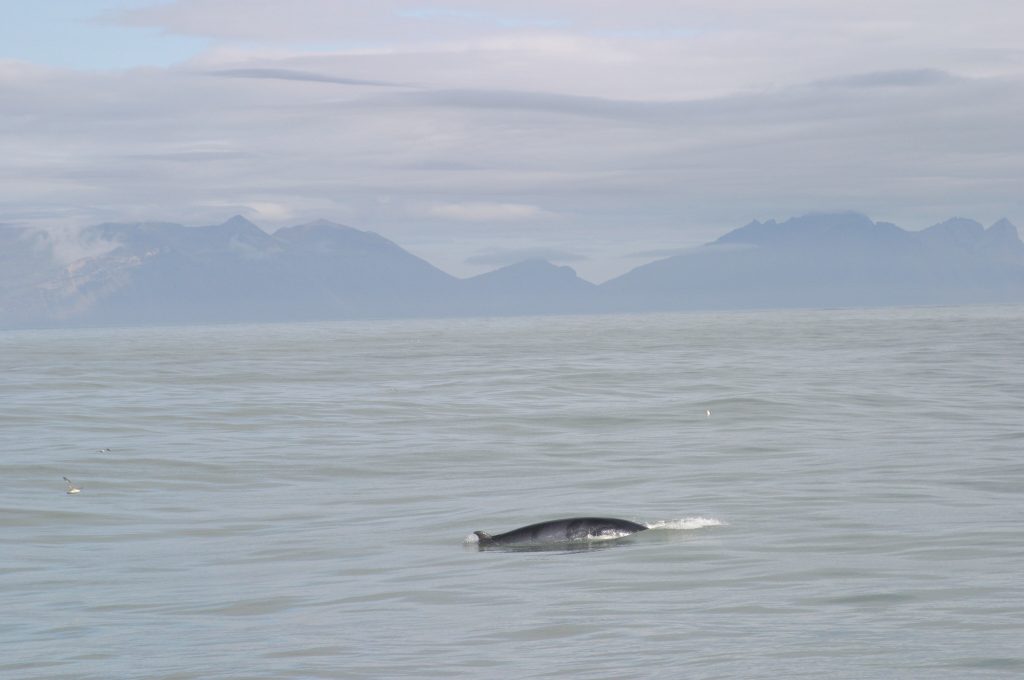
Minke whale off Iceland. © Marine and Freshwater Research Institute, Iceland.
Research in NAMMCO Member Countries
All NAMMCO member countries (as well as Canada) have participated in the NASS and T-NASS surveys and the common minke whale has been a target species in all areas. These surveys are coordinated through the Scientific Committee of NAMMCO. In addition, each country conducts other important research on the biology and ecology of common minke whales.
Greenland
Aerial surveys primarily directed at common minke whales are carried out periodically in Greenlandic waters (Heide-Jørgensen et al. 2008, 2010, Hansen et al. 2018). The 2007 survey included still and video camera systems as well as human observers. The data analysis was innovative in using data obtained from aerial photography and satellite tags to correct the survey for whales that were submerged during the passage of the plane.
Minke whales off Maniitsoq, West Greenland, was one of the target species for telemetry studies in 2018 and 2019 (National Progress Report Greenland 2018, 2019).
Greenlandic researcher Dr. Heide-Jørgensen is a leader in the development of equipment and techniques for tagging whales with satellite-linked transmitters, and particularly tag development. Such tags have been used on several species in Greenland, Iceland, Norway and other areas. Common minke whales have proven to be one of the most difficult whales to tag successfully, as they are difficult to approach, offer a relatively small target and seem to shed tags effectively. The longest tag duration so far achieved is 101 days, although less than 30 days is more typical, and some tags never transmit at all (Víkingsson and Heide-Jørgensen 2013). The tags and the tagging technique are still under active development and will likely provide further valuable information on minke whales in the future.
Iceland
The Minke Whale Research Program

The Icelandic Minke Whale Research Program. Sampling of blubber thickness © Marine and Freshwater Research Institute, Iceland.
After rejoining the IWC in 2003, Iceland initiated work on a whale research program that was initially planned to include lethal sampling of common minke, fin and sei whales. Takes of the latter two species were later dropped from the program and it became the Minke Whale Research Program. Such whaling is permitted under Article VIII of the International Convention on the Regulation of whaling, which allows contracting governments to grant special permits for scientific research. The main objective of the Program was to collect information on the feeding ecology of minke whales for incorporation into multi-species ecosystem models, with the overall goal of including these models into management programs for fish and marine mammals. Other objectives included investigations into stock structure, distribution and migration, growth and life history, parasites, diseases, biological parameters and pollutants (NAMMCO 2003, Pampoulie et al. 2013).
While initially envisaged to last for two years, the program was extended until 2007. Over this period, a total of 190 minke whales were taken, with catches distributed around Iceland in proportion to the relative abundance observed from sightings surveys. More than 70 measurements and 80 samples were taken from each whale captured. The results, summarized by Pampoulie et al. (2013), were presented at a special IWC meeting in February 2013.
Diet and feeding studies
The results from the diet and feeding studies demonstrate that minke whales are opportunistic feeders that feed predominantly on fish. There is also some indication that the diet of minke whales in the area is changing in response to changes in the marine ecosystem. While sandeels dominated the diet in southern areas, it became less important after the stock of sandeels declined. Over the same period herring became much more important in the diet. There have also been shifts in minke whale distribution that may be related to these changes in fish populations in the area. These in turn might be related to a recent increase in sea temperature in the area.
Length, age, abundance and catch data from the research program and previous work using commercial catches were included in a stock assessment model called Gadget, which can be expanded into a multi-species model. In this implementation, minke whale abundance was modelled to respond to the relative abundance of sandeels, a favoured prey in this area that has declined in recent years. The modelling outcomes show good fit to the available data and confirm that whaling mortality is very low for this stock. In the future, the model will be expanded to include other species in order to further determine the role of the common minke whale in the marine ecosystem around Iceland.

The Icelandic Minke Whale Research Program. Sampling of stomach content. © Marine and Freshwater Research Institute, Iceland.
Other key results of the Program
Determining common minke whale age using earplugs or tympanic bullae was found to be unreliable. Aging using aspartic acid racemisation in the eye lens was found to be more accurate and reliable, revealing ages up to 42 years.
Common minke whales accumulate blubber rapidly over the spring, summer and fall, with a mature whale adding as much as 500 kg of blubber on the feeding grounds. This energy reserve can then be used for growth, reproduction and migration to and from the breeding grounds.
Satellite tagging was attempted on 12 common minke whales, and tags were successfully deployed on six whales (Víkingsson and Heide-Jørgensen 2013, 2014). Of these, three endured into the whale’s fall southward migration. These whales migrated southwards in the mid-Atlantic, one of them reaching 28°S when transmissions ceased in early December. Migrating whales moved much faster than those on the Icelandic shelf, well over 100 km per day on average.
Genetics
Genetic analyses have been performed on a dataset that includes 737 minke whale samples from Iceland (National Progress Report Iceland 2020). This data has been analysed for affinity of Icelandic minke whales to other regions of the North Atlantic. Microsatellite data are currently used to infer Parent-Offspring (PO) pairs, which can provide information about regional and ocean-wide movements.
New nuclear Single Nucleotide Polymorphisms (SNPs) have also been developed through work performed on 4 minke whales from the North Atlantic, including 2 from Iceland. These SNPs will form the basis for the development of a minke whale SNP panel to help assess population structure across the entire North Atlantic.
Photo-identification
The Húsavík Research Centre performs long-term photo-identification and sightings studies of minke whales.
Faroe Islands
Minke whales are not taken or frequently sighted in the Faroes, and therefore are not a subject of priority research there.
Norway
Sightings and ecosystem surveys
The Norwegian mosaic sighting survey program (NILS) continues to be carried out every 6 years to provide abundance estimates for minke whales in the northeast Atlantic as part of the management scheme established for this species. The last completed six-year survey period was 2014–2019 and will result in a new abundance estimate in 2021. The current survey cycle is for the period 2020–2025 and began in the summer of 2020.
Every autumn from August–October, Norway has marine mammal observers onboard the vessels participating in the Barents Sea ecosystem survey, which is a joint effort with Russia. Some results from these surveys, assessing the associations between baleen whales and their prey, were published by Skern-Mauritzen et al. (2011).
Ecosystem-based management
Norway, along with other NAMMCO member countries, has a long-term goal of implementing ecosystem-based management for its fisheries and marine mammal hunts. This involves food web modelling to determine what impact the harvesting (or not harvesting) of one species might have on others in the ecosystem. Norway has concentrated its efforts in this area on modelling the Barents Sea ecosystem, which is relatively simple and has just a few very abundant species.
Modelling requires extensive data on diet and energy requirements by age and size for all major species in the ecosystem, as well as information on the seasonal distribution and abundance of these species. These data are input into complex mathematical ecosystem models with acronyms such as SeaStar, Bifrost and GADGET. Output from these modelling efforts confirm that the common minke whale is an important predator in the Barents Sea ecosystem, inflicting major mortality on adult and juvenile herring, cod and capelin (NAMMCO 2010).
In 2019, the first review of baleen whale ecology in high-latitude marine ecosystems of both the north Atlantic and north Pacific was published, with members of the NAMMCO Scientific Committee involved as co-authors (Moore et al. 2019). The review was performed to provide a circumpolar baseline of population estimates and habitats for these species and to assess their capacity as ecosystem sentinels.

Satellite tagging of a common minke whale in summer 2014 off Norway. The carrier for the satellite tag, that can be seen on the back of the whale, will fall of quite soon after the tag is implanted into the whale and leave the tag inside. © K.A. Fagerheim, IMR, Norway.
DNA register
The DNA register, for which DNA profiles are taken from every common minke whale caught, has found uses outside the monitoring of legal catch in Norway (Glover et al. 2011). Skaug and Øien (2005) analysed the profiles of 288 mother-foetus pairs in the registry to determine the partial DNA profile of the father in each case. They then searched the register to determine if the father had also been caught. They were able to identify three likely cases of paternity in the dataset.
Such DNA data can be informative for understanding stock relationships in the area, as the time and location of every kill is known. Using data from the DNA register, Quintela et al. (2014) found no evidence to support the existence of spatial or cryptic population genetic structure of minke whales in the Northeast Atlantic. Data from the register can probably also be used to roughly estimate the number of minke whales in the area through genetic “mark-recapture” analysis; this produces an estimate similar to those from sightings surveys, but with greater uncertainty because of the low number of recaptures.
In addition to this, the register has also been used to identify occasional instances of Antarctic minke whales and hybrids between the Antarctic and North Atlantic minke whale in the catch. The Antarctic minke whale is, a species previously thought to occur only in the southern hemisphere (Glover et al. 2010, 2013).
Satellite telemetry
Common minke whales are widely dispersed in the Northeast Atlantic during the summer but virtually nothing is known about their movements, site fidelity and dispersal patterns in this area, especially in winter. Satellite telemetry is a powerful tool for collecting data on migration, winter distribution and key behavioural and physiological parameters of cetacean species. Norway started satellite tagging minke whales in September 1994 (Heide-Jørgensen et al. 2001) in the attempt of identifying their seasonal movement patterns along the coast of Norway.
Morphology
In 2018, a joint Japanese-Norwegian cooperation studied the possible morphological differences of the white flipper patch between the North Atlantic and North Pacific common minke whales, with the results showing clear morphological differences (Nakamura et al. 2018).
Ecological studies
Substantial changes have occurred in the Barents Sea ecosystem over the past 30 years, the most conspicuous related to the rise and fall of stocks of the two dominant pelagic shoaling fish species: capelin and herring. Based on data from annual studies, effects of these ecological changes on the diet and food consumption of the minke whale were assessed for the period 1992–1999 (Haug et al. 2002, Lindstrøm and Haug 2001). The whales exploited a variety of species and sizes of fish and crustaceans. In general, they selectively foraged on capelin, herring and occasionally krill, but switched to other prey in years of low densities of herring and capelin. Following a collapse in the capelin stock in 1992–1993, minke whales foraging in the northern Barents Sea switched from a capelin-dominated diet to a diet almost completely comprised of krill. The southern region of the Barents Sea represents important nursery areas for the Norwegian spring spawning herring. Good recruitment to this stock gives strong cohorts and large numbers of young, immature herring (0–3 years old) that serve as the main food for minke whales feeding in the area. Similar to other baleen whales, minke whales improve their body condition by increasing their fat deposits during the feeding period, and thereby store energy reserves for wintering and breeding at lower latitudes when their feeding activity probably is reduced. Comparison of minke whales’ body condition in years of high and low abundances of immature herring showed that minke whales in the southern Barents Sea, particularly immatures and adult females, were in significantly better condition in years when the abundance of immature herring was high (Haug et al. 2002).
More recent studies (2000–2004 and 2010–2011) confirmed previous findings of significant differences in diet composition between areas and some differences between years (Windsland et al. 2007, Meier et al. 2016). The importance of krill in the Barents Sea increased with latitude and dominated the Spitsbergen diet. Capelin dominated the diet around Bear Island and contributed considerable to the diet along the coast of northern Norway. In the latter area, herring and haddock were also a large part of the diet. The considerable size range of consumed prey (0.2–78 cm) confirms previous findings that minke whales are not particularly size selective (Windsland et al. 2007). The size of prey seems to be determined by the availability of different size classes, rather than selectivity by the whales (Lindstrøm and Haug 2001, Windsland et al. 2007).
During the commercial catch operations on feeding grounds in Norwegian waters, body condition data (blubber thickness and girth) have been collected from 13,216 common minke whales caught in 1993–2018. This time series has been used to investigate associations between body condition and time/area in minke whales. The observed common minke whale body condition was at its lowest in 2015, whereafter it has increased. This may support a connection between cod abundance and feeding conditions for other top predators such as common minke whales (National Progress Report Norway 2019). Sampling of minke whale stomach contents and life history parameters will be performed during the commercial hunt in June 2021.
Audunsson, G.A., Nielsen, N.H., Víkingsson, G.A. et al. (2013). Age estimation of common minke whales (Balaenoptera acutorostrata) in Icelandic waters by aspartic acid racemisation and earplug readings of Antarctic minke whales (B. bonaerensis) used as a reference. SC/F13/SP15 for the IWC Scientific Committee.
Borchers, D.L., Pike, D.G., Gunnlaugsson, Th. and Vikingsson, G.A. (2009). Minke whale abundance estimation from the NASS 1987 and 2001 aerial surveys using cue counting with distance estimation errors. NAMMCO Scientific Publications, 7, 95–110. https://doi.org/10.7557/3.2708
Christiansen, F., Víkingsson, G. A., Rasmussen, M. H. and Lusseau, D. (2013). Minke whales maximise energy storage on their feeding grounds. Journal of Experimental Biology, 216, 427–436. https://doi.org/10.1242/jeb.074518
Cooke, J.G. 2018. Balaenoptera acutorostrata. The IUCN Red List of Threatened Species 2018: e.T2474A50348265. https://dx.doi.org/10.2305/IUCN.UK.2018-2.RLTS.T2474A50348265.en. Accessed on 19 December 2023.
Donovan, G.P. (1991). A review of the IWC stock boundaries. Report of the International Whaling Commission, 13, 39–68.
Ford, J.K.B., Ellis, G.M., Matkin, D.R., Balcomb, K.C., Briggs , D. and Morton, A.B. (2005). Killer whale attacks on minke whales: Prey capture and antipredator tactics. Marine Mammal Science, 21, 603–618. https://doi.org/10.1111/j.1748-7692.2005.tb01254.x
Glover, K.A., Haug, T., Øien, N., Walløe, L., Lindblom, L., Seliussen, B.B. and Skaug, H.J. (2011). The Norwegian minke whale DNA register: a data base monitoring commercial harvest and trade of whale products. Fish and Fisheries, 13, 313–332. https://doi.org/10.1111/j.1467-2979.2011.00447.x
Glover, K.A., Kanda, N., Haug, T, Pastene, L.A., Øien, N., Goto, M., Seliussen, B.B. and Skaug, H.J. (2010). Migration of Antarctic minke whales to the Arctic. PloS One, 5, e15197. https://doi.org/10.1371/journal.pone.0015197
Glover, K.A., Kanda, N., Haug, T., Pastene, L.A., Øien, N., Seliussen, B.B., Sørvik, A.G.E. and Skaug, H.J. (2013). Hybrids between common and Antarctic minke whales are fertile and can back-cross. BMC Genetics, 14, 25–36. https://doi.org/10.1186/1471-2156-14-25
Greenland. (2018). White paper on the management and utilization of large whales in Greenland. https://nammco.no/wp-content/uploads/2020/05/greenland-whitepaper-on-whaling-2018-iwc-final.pd_.pdf
Gunnlaugsson, T., Vikingsson, G.A., Halldorsson, S.D., Elvarsson, B.Þ., Haug, T. and Lydersen, C. (2020). Body mass, muscle, blubber and visceral fat content and their seasonal, spatial and temporal variability in North Atlantic common minke whales. Journal of Cetacean Research and Management, 21, 59–70.
Hansen, R.G., Boye, T.K., Larsen, R.S. et al. (2018). Abundance of whales in West and East Greenland in summer 2015. NAMMCO Scientific Publications, 11. https://doi.org/10.7557/3.4689
Haug, T., Bjørge, A., Øien, N. and Ziryanov, S.V. (2011). 7. Marine mammals; 7.1 Marine mammals of the Barents Sea. In T. Jakobsen and V.K. Ozhigin (eds), The Barents Sea; Ecosystem, resources, management; Half a century of Russian-Norwegian cooperation, 395–430. Tapir Academic Press.
Haug, T., Bogstad, B., Chierici, M., Gjøsæter, H., Hallfredsson, E.H., Høines, Å.S., Hoel, A.H., Ingvaldsen, R.B., Jørgensen, L.L., Knutsen, T., Loeng, H., Naustvoll, L.-J., Røttingen, I. and Sunnanå, K. (2017). Future harvest of living resources in the Arctic Ocean of the Nordic and Barents Seas: A review of possibilities and constraints. Fisheries Research, 188, 38–57. https://doi.org/10.1016/j.fishres.2016.12.002
Haug, T., Lindstrøm, U. and Nilssen, K.T. (2002). Variations in minke whale Balaenoptera acutorostrata diets in response to environmental changes in the Barents Sea. Sarsia, 87, 409–422.
Heide-Jørgensen, M.P., Witting, L., Laidre, K.L. et al. (2010). Fully corrected estimates of common minke whale abundance in West Greenland in 2007. Journal of Cetacean Research and Management, 11, 75–82. Available at https://archive.iwc.int/pages/search.php?search=!collection15&bc_from=themes
Heide-Jørgensen, M.P., Borchers, D.L., Witting, L. et al. (2008). Estimates of large whale abundance in West Greenland waters from an aerial survey in 2005. Journal of Cetacean Research and Management, 10(2), 119–130. Available at https://archive.iwc.int/pages/search.php?search=!collection15&bc_from=themes
Heide-Jørgensen, M. P., Nordøy, E. S., Øien, N. et al. (2001). Satellite tracking of minke whales (Balaenoptera acutorostrata) off the coast of northern Norway. Journal of Cetacean Research and Management, 3(2), 175–178. Available at https://archive.iwc.int/pages/search.php?search=!collection15&bc_from=themes
Higdon, J.W. and Ferguson, S.H. (2011). Reports of humpback and minke whales in the Hudson Bay Region, Eastern Canadian Arctic. Northeastern Naturalist, 18, 370–377. https://doi.org/10.1656/045.018.0309
Horwood, J. (1990). Biology and exploitation of the minke whale. Boca Raton, Florida: CRC Press, Inc.
International Whaling Commission (IWC). (2010). Report of the Scientific Assessment Group. IWC/N10/SWG6. 14 pp.
International Whaling Commission (IWC). (2010). Report of the Scientific Committee. Journal of Cetacean Research Management, 11 (Suppl. 2). Available at https://archive.iwc.int/pages/search.php?search=!collection15&bc_from=themes
International Whaling Commission (IWC). (2014a). Report of the AWMP/RMP Joint Workshop on the stock structure of North Atlantic common minke whales. SC/65b/REP04.
International Whaling Commission (IWC). (2014b). Implementation Review for North Atlantic common minke whales. SC/65b/RMPWP24.
International Whaling Commission (IWC). (2016). Report of the Scientific Committee. Annex D: Report of the Sub-Committee on the Revised Management Procedure. Journal of Cetacean Research Management 17, 106–184. Available at https://archive.iwc.int/pages/search.php?search=!collection15&bc_from=themes
International Whaling Commission (IWC). (2018). Report of the Scientific Committee. Bled, Slovenia. Available at https://archive.iwc.int/pages/search.php?search=%21collection73&k=
Jonsgård, Å. (1951). Studies of the little piked whale or minke whale (Balaenoptera acutorostrata Lacepede). Norsk Hvalfangst-Tidende, 40(5), 209–232.
Jonsgård, Å. (1966). The distribution of Balaenopteridae in the North Atlantic ocean. In K. S. Norris (ed.),. Whales, dolphins and porpoises, 114–124. Berkelyy and Los Angeles: University of California Press.
Kalland, A. (1995). Marine mammals in the culture of Norwegian coastal communities. In A.S. Blix, L. Walløe and Ø. Ulltang (eds.), Whales, seals, fish and man, 689–697. Amsterdam: Elsevier. https://doi.org/10.1016/S0163-6995(06)80068-5
Laidre, K. L., Heagerty, P. J., Heide-Jørgensen, M. P. et al. (2009). Sexual segregation of common minke whales (Balaenoptera acutorostrata) in Greenland, and the influence of sea temperature on the sex ratio of catches. ICES Journal of Marine Science, 66, 2253–2266. https://doi.org/10.1093/icesjms/fsp191
Larsen, F. (1995). Abundance of minke and fin whales off West Greenland, 1993. Report of the International Whaling Commission, 45, 365–370.
Larsen, S.E. and Hansen, K.G. (1997). Inuit and whales at Sarfaq (Greenland). In M.G. Stevenson, A. Madsen and E. Maloney (eds.), The Anthropology of Community-Based Whaling in Greenland, 191–222. University of Alberta, Canada: Canadian Circumpolar Institute.
Lawson, J. and Gosselin, J-F. (2018). Estimates of cetacean abundance from the 2016 NAISS aerial surveys of eastern Canadian waters, with a comparison to estimates from the 2007 TNASS. SC/25/AE/09 for the NAMMCO Scientific Committee.
Lindstrøm, U. and Haug, T. (2001). Feeding strategy and prey selectivity in minke whales (Balaenoptera acutorostrata) foraging in the southern Barents Sea during early summer. Journal of Cetacean Research and. Management, 3, 238–249.
Martin, A.R., Donovan, G.P, Leatherwood, S. et al. (1990). Whales and dolphins. London: Bedford Editions Ltd.
Meier, S., Falk-Petersen, S., Gade-Sørensen, L.A., Greenacre, M., Haug, T. and Lindstrøm, U. (2016). Fatty acids in common minke whale (Balaenoptera acutorostrata) blubber reflect the feeding area and food selection, but also high endogenous metabolism. Marine Biology Research, 12, 221–238. https://doi.org/10.1080/17451000.2015.1118513
Moore, S.E., Haug, T., Víkingsson, G.A. and Stenson, G.B. (2019). Baleen whale ecology in arctic and subarctic seas in an era of rapid habitat alteration. Progress in Oceanography, 176, 102118.
Nakamura, G., Ryeng, K.A., Kadowaki, I. et al. (2018). Comparison of shapes of the white flipper patch between two subspecies of common minke whales (Balaenoptera acutorostrata). Cetacean Population Studies, 1, 15-24. Available at https://cpops.jp/archive/pdf/00115-24.pdf
National Progress Report Norway. (2019). Norway National Progress Report on Marine Mammals 2019. Available at https://nammco.no/member-country-progress-reports/
North Atlantic Marine Mammal Commission (NAMMCO). (1998). Report of the Working Group on the Role of Minke Whales, Harp Seals and Hooded Seals in North Atlantic Ecosystems. Available at https://nammco.no/topics/sc-wg-reports/
North Atlantic Marine Mammal Commission (NAMMCO). (1999). Report of the NAMMCO Scientific Committee Working Group on Management Procedures. In NAMMCO Annual Report 1998, NAMMCO, Tromsø, Norway, 117–131. Available at https://nammco.no/topics/annual-reports/
North Atlantic Marine Mammal Commission (NAMMCO). (2003). Norway: National Progress Report 2001. In NAMMCO Annual Report 2002. NAMMCO, Tromsø, Norway, 285–290. Available at https://nammco.no/topics/annual-reports/
North Atlantic Marine Mammal Commission (NAMMCO). (2004). Norway: National Progress Report. In NAMMCO Annual Report 2004. NAMMCO, Tromsø, Norway, 309–330. Available at https://nammco.no/topics/annual-reports/
North Atlantic Marine Mammal Commission (NAMMCO). (2005). Norway: National Progress Report. In NAMMCO Annual Report 2004. NAMMCO, Tromsø, Norway, 337–358. Available at https://nammco.no/topics/annual-reports/
North Atlantic Marine Mammal Commission (NAMMCO). (2007). Norway: National Progress Report. In NAMMCO Annual Report 2006: Volume II. NAMMCO, Tromsø, Norway, 519–545. Available at https://nammco.no/topics/annual-reports/
North Atlantic Marine Mammal Commission (NAMMCO). (2010). Norway: National Progress Report. In NAMMCO Annual Report 2010. NAMMCO, Tromsø, Norway, 451–478. Available at https://nammco.no/topics/annual-reports/
North Atlantic Marine Mammal Commission (NAMMCO). (2011a). Report of the NAMMCO Expert Group meeting on the assessment of whale killing data. In NAMMCO Annual Report 2010. NAMMCO, Tromsø, Norway, 57–84. Available at https://nammco.no/topics/annual-reports/
North Atlantic Marine Mammal Commission (NAMMCO). (2011b). Report of the Scientific Committee. In NAMMCO Annual Report 2010. NAMMCO, Tromsø, Norway, 235–412. Available at https://nammco.no/topics/annual-reports/
North Atlantic Marine Mammal Commission (NAMMCO). (2012a). Report of the eighteenth meeting of the Scientific Committee. In NAMMCO Annual Report 2011. NAMMCO, Tromsø, Norway, 229–434. Available at https://nammco.no/topics/annual-reports/
North Atlantic Marine Mammal Commission (NAMMCO). (2012b). Report of the nineteenth meeting of the Scientific Committee. In NAMMCO Annual Report 2012. NAMMCO, Tromsø, Norway, 263–550. Available at https://nammco.no/topics/annual-reports/
North Atlantic Marine Mammal Commission (NAMMCO). (2015). Report of the Scientific Committee Working Group on large whale assessment. In NAMMCO Annual Report 2015. NAMMCO, Tromsø, Norway, 238–247. Available at https://nammco.no/topics/annual-reports/
North Atlantic Marine Mammal Commission (NAMMCO). (2016). Report of the Scientific Committee Working Group on Abundance Estimates. In NAMMCO Annual Report 2016, NAMMCO, Tromsø, 221–248. Available at https://nammco.no/topics/annual-reports/
North Atlantic Marine Mammal Commission (NAMMCO). (2017). Report of the 24th Scientific Committee meeting, Reykjavík, Iceland. Available at https://nammco.no/topics/scientific-committee-reports/
North Atlantic Marine Mammal Commission (NAMMCO). (2018). Report of the Working Group on Abundance Estimates, Copenhagen, Denmark. Available at https://nammco.no/topics/abundance_estimates_reports/
North Atlantic Marine Mammal Commission (NAMMCO). (2019). Report of the 26th Scientific Committee Meeting, Tórshavn, Faroe Islands. Available at https://nammco.no/topics/scientific-committee-reports/
National Oceanographic and Atmospheric Administration (NOAA). Minke whale. Available at http://www.nmfs.noaa.gov/pr/species/mammals/cetaceans/minkewhale.htm
Ólafsdóttir, D. and Shinn, A.P. (2013). Epibiotic macrofauna on common minke whales, Balaenoptera acutorostrata Lacépède, 1804, in Icelandic waters. Parasites and vectors, 6(1), 105. https://doi.org/10.1186/1756-3305-6-105
Palsbøll, P.J., Berube, M., Skaug, H.J. and Raymakers, C. (2006). DNA registers of legally obtained wildlife and derived products as means to identify illegal takes. Conservation Biology, 20(4), 1284–1293. https://doi.org/10.1111/j.1523-1739.2006.00429.x
Pampoulie, C., Gunnlaugsson, Th., Elvarsson, B. et al. (2013). Research program on common minke whale (Balaenoptera acutorostrata) in Icelandic waters. An overview of implementation and results. SC/F13/SP1 for the IWC Scientific Committee. Available at http://events.iwc.int/index.php/workshops/ISPEPR2013/paper/viewFile/76/55
Pike, D.G. (2018). Abundance of common minke whales in the Central Medium Area in 2015. SC/25/AE/08 for the NAMMCO Scientific Committee.
Pike, D.G., Gunnlaugsson, T., Víkingsson, G. A. and Sigurjónsson, J. (2020). Distribution and abundance of cetaceans in Icelandic waters over 30 years of aerial surveys. NAMMCO Scientific Publications, 11. https://doi.org/10.7557/3.4805
Quintela, M., Skaug, H.J., Øien, N., Haug, T., Seliussen, B., Solvang, H.K., Pampoulie, C., Kanda, N., Pastene, L.A. and Glover, K. (2014). Investigating population genetic structure in a highly mobile marine organism: the minke whales Balaenoptera acutorostrata acutorostrata in the north east Atlantic. PLoS ONE, 9(9), e108640. https://doi.org/10.1371/journal.pone.0108640
Sejersen, F. (2001). Hunting and management of beluga whales (Delphinapterus leucas) in Greenland: Changing strategies to cope with new national and local interests. Arctic, 54, 431–443. https://doi.org/10.14430/arctic800
Schweder, T., Skaug, H.J., Dimakos, X.K. et al. (1997). Abundance of northeastern Atlantic minke whales, estimates for 1989 and 1995. Report of the International Whaling Commission, 47, 453–484.
Sharpe, M. & Berggren, P. 2023. Balaenoptera acutorostrata (Europe assessment). The IUCN Red List of Threatened Species 2023: e.T2474A219011809. Accessed on 19 December 2023.
Sigurgeirsson, S. (2001). Iceland. Gastronomica: The journal of food and culture, 1, 86–89. https://doi.org/10.1525/gfc.2001.1.2.86
Sigurjónsson, J. (1989). To Iceland, whales were a godsend. Oceanus, 32, 24–41.
Sigurjónsson, J. (1997). Whale resources in the North Atlantic and the concept of sustainability. In G. Pétursdóttir (ed.), Whaling in the North Atlantic, 17–32. University of Iceland Press.
Sigurjónsson, J. and Vikingsson, G. (1997). Seasonal abundance of and estimated food consumption by cetaceans in Icelandic and adjacent waters. Journal Northwest Atlantic Fishery Science, 22, 271–287. https://doi.org/10.2960/J.v22.a20
Skaug, H.J. and Øien, N. (2005). Genetic tagging of male North Atlantic minke whales through comparison of maternal and foetal DNA-profiles. Journal of Cetacean Research and Management, 7, 113–117. Available at https://www.researchgate.net/publication/288847321
Skaug, H.J., Øien, N., Schweder, T. and Bøthun, G. (2004). Abundance of minke whales (Balaenoptera acutorostrata) in the Northeast Atlantic: variability in time and space. Canadian Journal of Fisheries and Aquatic Science, 61, 870–886. https://doi.org/10.1139/f04-020
Skern-Mauritzen, M., Johannesen, E., Bjørge, A. and Øien, N. (2011). Baleen whale distribution and prey associations in the Barents Sea. Marine Ecology Progress Series, 426, 289–301. https://doi.org/10.3354/meps09027
Solvang, H.K., Skaug, H.J. and Øien, N. (2015). Abundance estimates of common minke whales in the Northeast Atlantic based on survey data collected over the period 2008–2013. SC/66a/RMP/8; Paper submitted to the IWC Scientific Committee 66a, San Diego, 22 May 2015.
Solvang, H.K., Skaug, H.J. and Øien, N. (2021). Abundance of common minke whales in the Northeast Atlantic based on survey data collected over the period 2014-2019. SC/68C/ASI/04; Paper submitted to the IWC Scientific Committee Virtual Meeting, 2021
Stefánsson, G., Sigurjónsson, J. and Vikingsson, G. (1997). On dynamic interaction between some fish resources and cetaceans off Iceland based on a simulation model. Journal of Northwest Atlantic Fisheries and Sciences, 22, 357–370. https://doi.org/10.2960/J.v22.a25
Toresen, R. et al. (1998). Havets ressurser 1998 [The sea’s resources 1998]. Fisken og Havet, Særnr. 1. [In Norwegian].
Víkingsson, G.A. and Heide-Jørgensen, M.P. (2013). Migration and local movements of common minke whales tracked by satellite in the North Atlantic during 2001–2010. SC/F13/SP18 for the IWC Scientific Committee. Available at http://events.iwc.int/index.php/workshops/ISPEPR2013/paper/viewFile/59/40
Víkingsson, G.A. and Heide-Jørgensen, M.P. (2014). First indications of autumn migration routes and destination of common minke whales tracked by satellite in the North Atlantic during 2001–2011. Marine Mammal Science, 31, 376385. https://doi.org/10.1111/mms.12144
Víkingsson, G.A., Elvarsson, B., Chosson, V. et al. (2013). Recent changes in the diet composition of common minke whales (Balaenoptera acutorostrata) in Icelandic waters. – Consequence of climate change? SC/F13/SP2 for the IWC Scientific Committee. https://doi.org/10.1080/17451000.2013.793812
Víkingsson, G.A., Pike, D.G., Valdimarsson, H. et al. (2015). Distribution, abundance, and feeding ecology of baleen whales in Icelandic waters: have recent environmental changes had an effect? Frontiers in Ecology and Evolution, 3. https://doi.org/10.3389/fevo.2015.00006
Wenzel G.W. (1995). Ningiqtuq: Resource sharing and generalized reciprocity in Clyde River, Nunavut. Arctic Anthropology, 32, 43–60. Available at http://connection.ebscohost.com/c/articles/9512292524/ningiqtuq-resource-sharing-generalized-reciprocity-clyde-river-nunavut
Windsland, K., Lindstrøm, U., Nilssen, K.T. and Haug, T. (2007). Relative abundance and size composition of prey in the common minke whale diet in selected areas of the northeast Atlantic during 2000–04. Journal of Cetacean Research and. Management, 9, 167–178.
Norwegian Institute of Marine Research – Minke whale
Norwegian Polar Institute – Minke whale
Norwegian Ministry of Trade, Industry and Fisheries – Whaling
University of Michigan Museum of Zoology, Animal Diversity Web – Common minke whale
IWC Revised Management Procedure (RMP)
